Glad you decided to stick around!
This is post #6 of 8 about my Summer 2024 visit to downtown Chicago:
B1: Chicago Overview, CityPASS, & Millennium Park
B2: Field Museum of Natural History
B3: Shedd Aquarium
B4: Museum of Science and Industry
B5: Art Institute of Chicago (Part 1)
B6: Art Institute of Chicago (Part 2) (this post)
B7: Willis/Sears Tower Skydeck, the Rookery, Chicago Fed Money Museum, Museum of Contemporary Photography, Chicago Cultural Center, & Design Museum of Chicago
B8: Medieval Torture Museum (NSFW)
This post will mainly be sharing the various pieces of artwork that I found most impressive or interesting at the Art Institute, along with some cute animal art. I had to break this post up into two parts due to size limits when posting. This posts covers Windows & Architecture, the Thorne Miniature Rooms, American Art, Modern Art, the Arts of Asia, China, Japan, and Korea, Arts of the Americas, and Photography. Last of all, I will cover the interesting things I found at the Gift Shop!
All of the pictures in this post were taken by me.
WINDOWS & ARCHITECTURE
America Windows, 1977
Stained glass
Dimensions: 96 × 385 in. (244 × 978 cm) (overall)
Marc Chagall
Born Vitebsk (formerly Russian Empire, now Belarus), 1887; died Saint-Paul, France, 1985
Marc Chagall made America Windows to celebrate the US Bicentennial and presented them as a gift to the Art Institute of Chicago in 1977. The windows merge symbols of US history, the Chicago skyline, and the arts; read from left to right, the panels represent music, painting, literature, architecture, theater, and dance.
Best known as a painter, Chagall had been working in stained glass for several decades by the 1970s. He was drawn to the medium as a way to explore intense color on a monumental scale. Working with stained-glass maker Charles Marq, Chagall executed 86 windows across Europe, Israel, and the United States.
A gift of Marc Chagall, the City of Chicago, and the Auxiliary Board of The Art Institute of Chicago, commemorating the American Bicentennial in memory of Mayor Richard J. Daley
1977.938
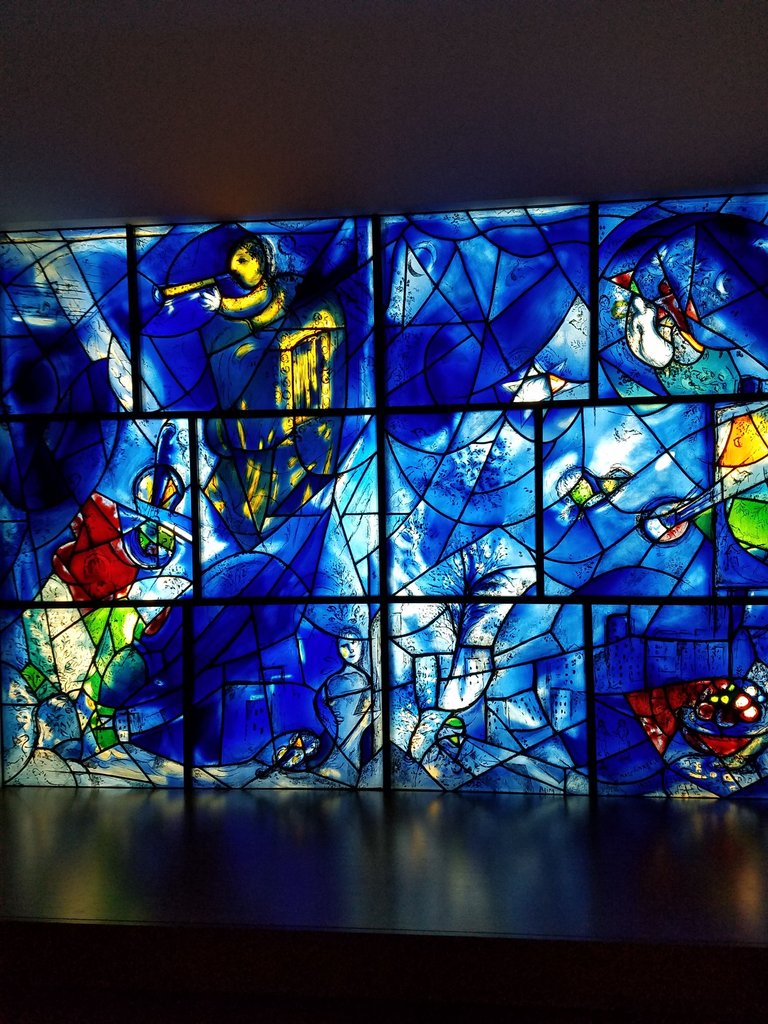

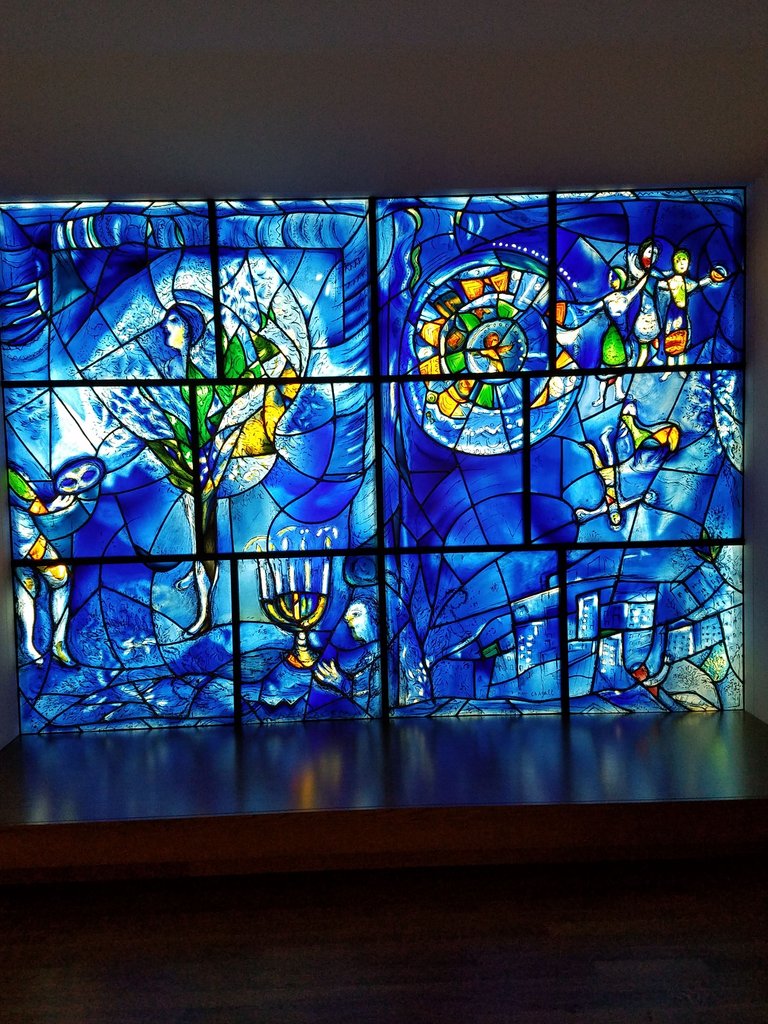
Lilies (Corey Memorial Window), 1892 – 1895
Leaded Favrile glass
Dimensions: 414 × 82.6 cm (163 × 32 1/2 in.)
Tiffany Glass and Decorating Company
American, 1894 – 1902
Corona, New York
This memorial window, dedicated to Francis Edwin Corey and his wife, Vernera Leonard Corey, is one of several that Louis Comfort Tiffany’s Tiffany Glass and Decorating Company designed for Christ Reformed Episcopal Church in Chicago. Tiffany used lilies in his stained glass a number of times; the Coreys may have been inspired to commission this design by the well-publicized Field of Lilies Window in Tiffany’s chapel at the 1893 World’s Columbian Exposition in Chicago. Lilies were also considered appropriate for commemorative works, since they symbolized resurrection. When Christ Reformed Episcopal Church was demolished in 1962, the Tiffany windows were moved to St. Andrew Reformed Episcopal Church in Tinley Park, Illinois. The two parts of the Corey Memorial Window are now displayed on either side of this wall.
Gift of St. Andrew Reformed Episcopal Church
2008.64
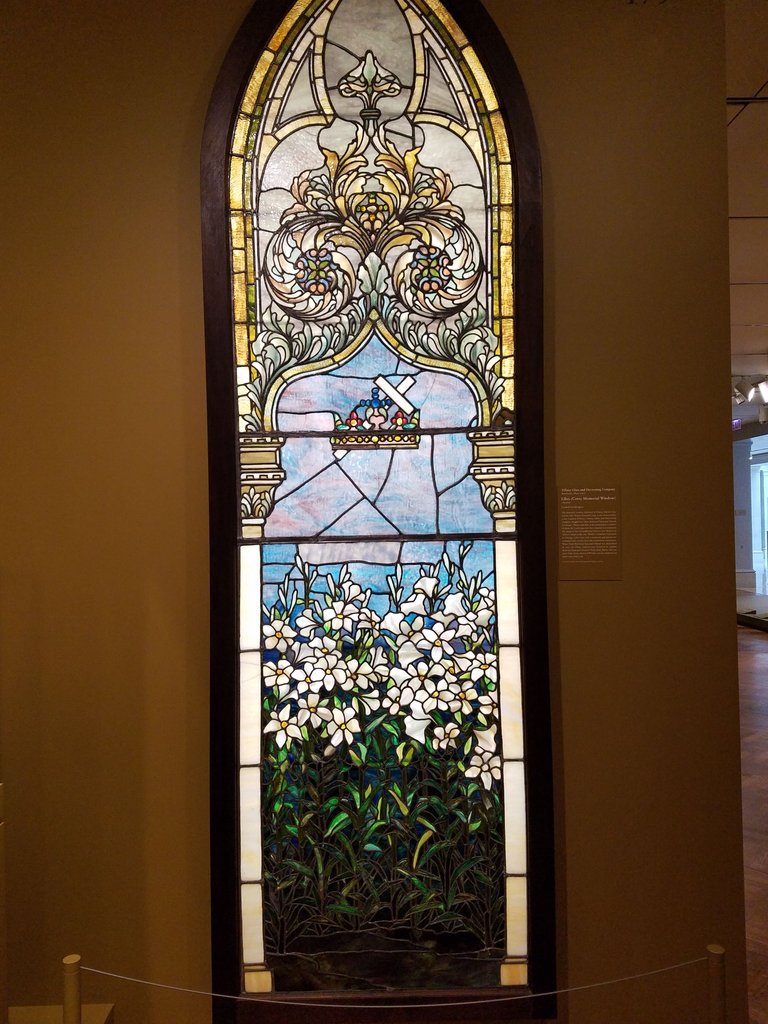
Hartwell Memorial Window, 1917
Leaded glass
Dimensions: 798.7 × 554.7 × 42.5 cm (314 7/16 × 218 3/8 × 16 3/4 in.)
Design attributed to Agnes F. Northrop
American, 1857 – 1953
Tiffany Studios
American, 1902 – 1932
Corona, New York
Presenting a soaring vista of an idealized view of Mount Chocorua, New Hampshire, the Hartwell Memorial Window is among the most complex stained-glass landscapes produced in the United States. Commissioned by Mary Hartwell as a memorial in honor of her husband Frederick for the Central Baptist Church of Providence, Rhode Island (now Community Church of Providence), the majestic scene was inspired by the view from his family home. Agnes F. Northrop designed the window at the height of her five-decade-long career at Tiffany Studios. She specialized in intricate landscapes and worked with a team of experts to realize the 25-foot-high window, which is made up of 48 individual panels. In order to achieve highly natural effects, artists used a kaleidoscopic variety of glass types, some of which are built up two to five layers thick.
The Hartwell Memorial Window remained housed in the sanctuary of the Community Church of Providence until 2018, when the congregation decided to relocate it to the Art Institute of Chicago, where it could be conserved to ensure its long-term stability and remain on public view. This majestic work is currently installed at the top of the Woman’s Board Grand Staircase, thanks to novel approaches to the window’s mounting, framing, and lighting.
2018.121
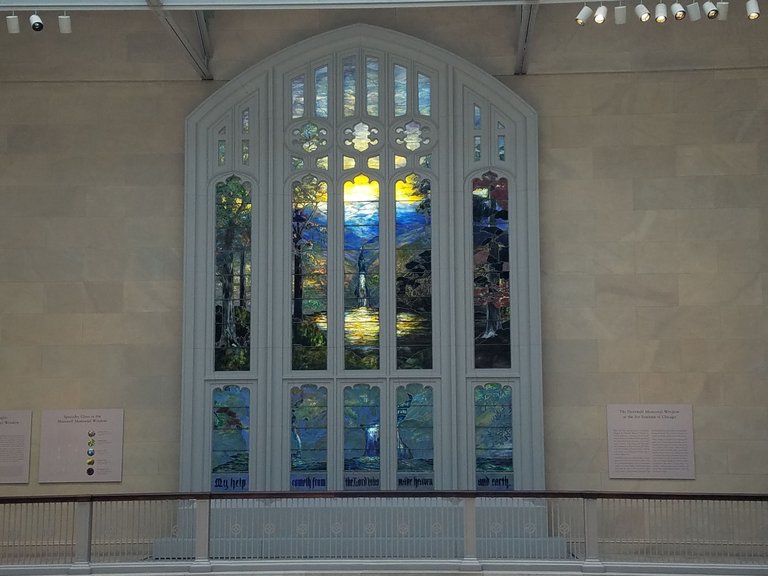
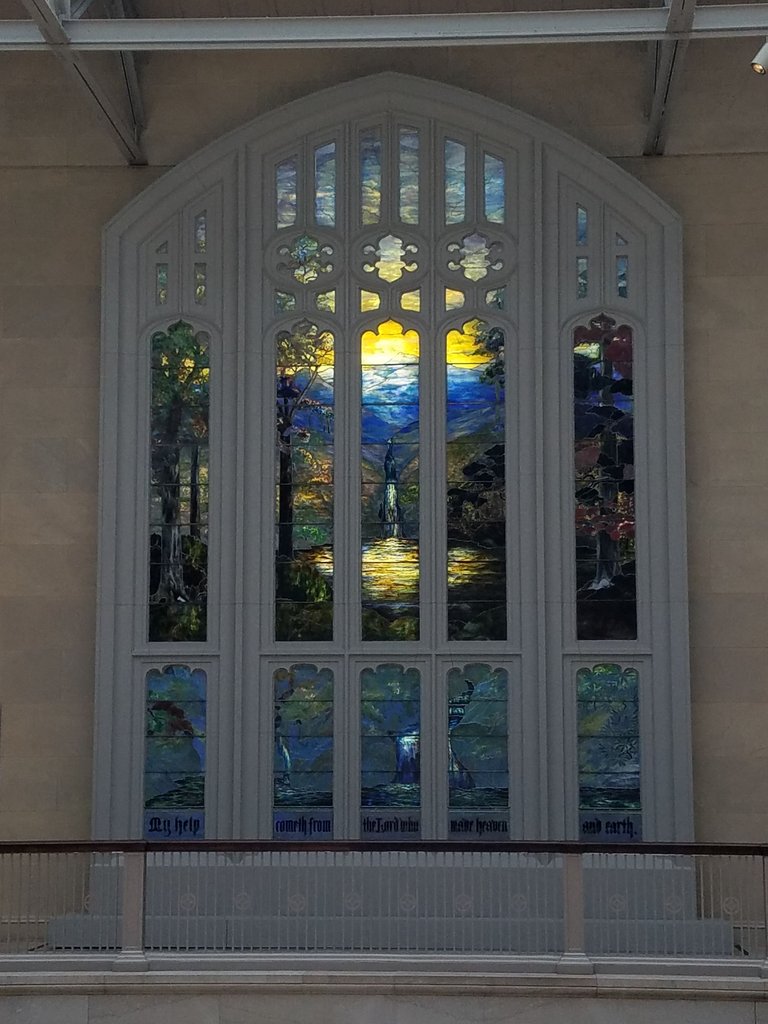
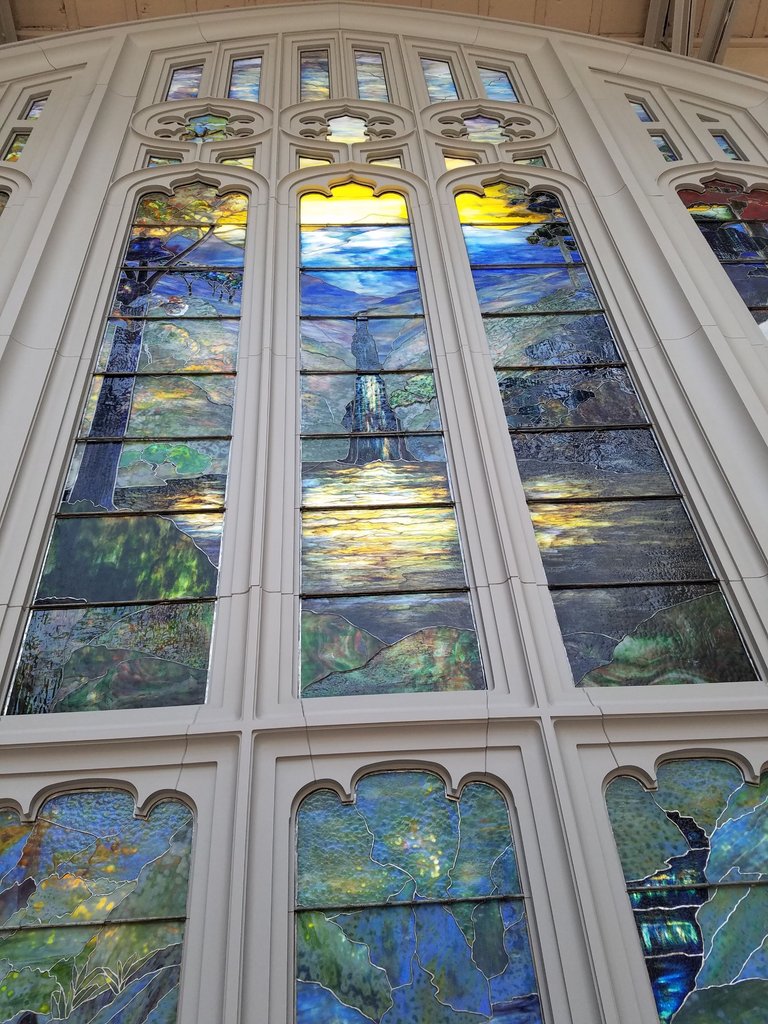
Some bird designs:
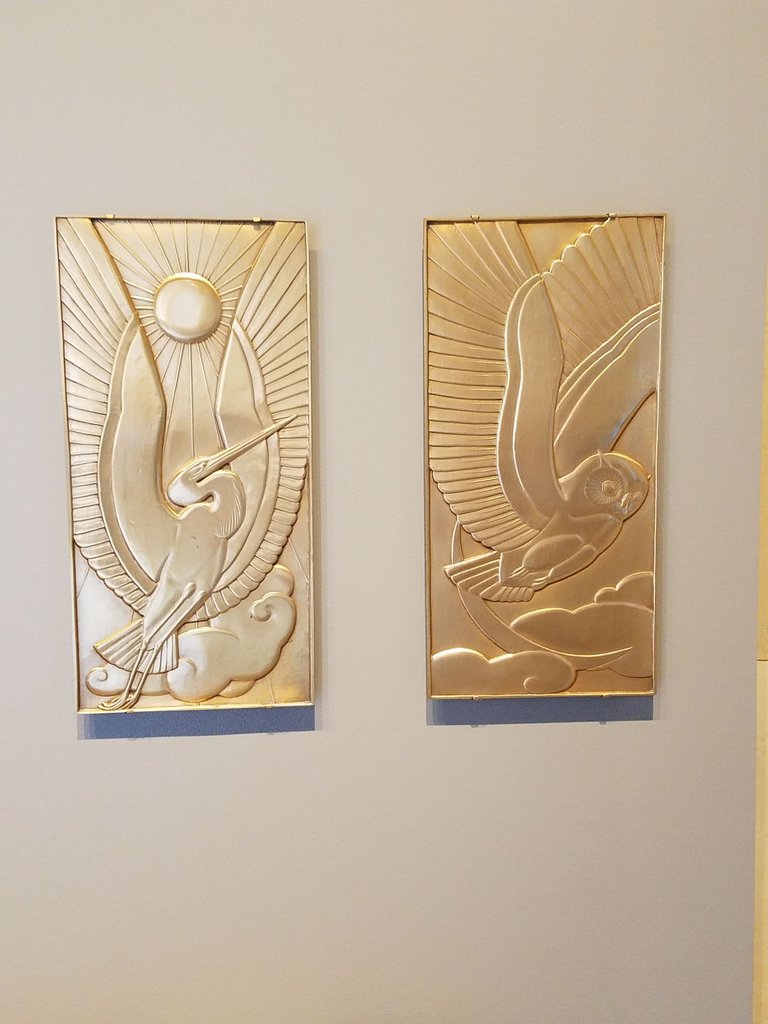
Window with Bird Design, c. 1925
Lead glass in wood frame
Dimensions: 69 × 20 cm (27 1/4 × 8 in.)
Edgar Miller
American, 1899 - 1993
The colorful birds featured in this stained-glass window reflect a prevailing theme of animals in Edgar Miller's interdisciplinary work. Much of his graphic design, sculpture, and applied arts reflects a deep engagement with the natural world, which Miller developed during his childhood in rural Idaho. Inspired by the colors and compositions of medieval stained glass, this window is an early example of the ornate architectural elements that Miller used for his interiors alongside plaster reliefs, handmade tiles, and intricately carved wood elements. Although his work is modern, Miller's representations of animals have a timeless quality that hearkens back to prehistoric cave paintings, a focus of his study at the School of the Art Institute of Chicago in the 1910s.
Mr. and Mrs. Frank G. Logan Fund
1925.45
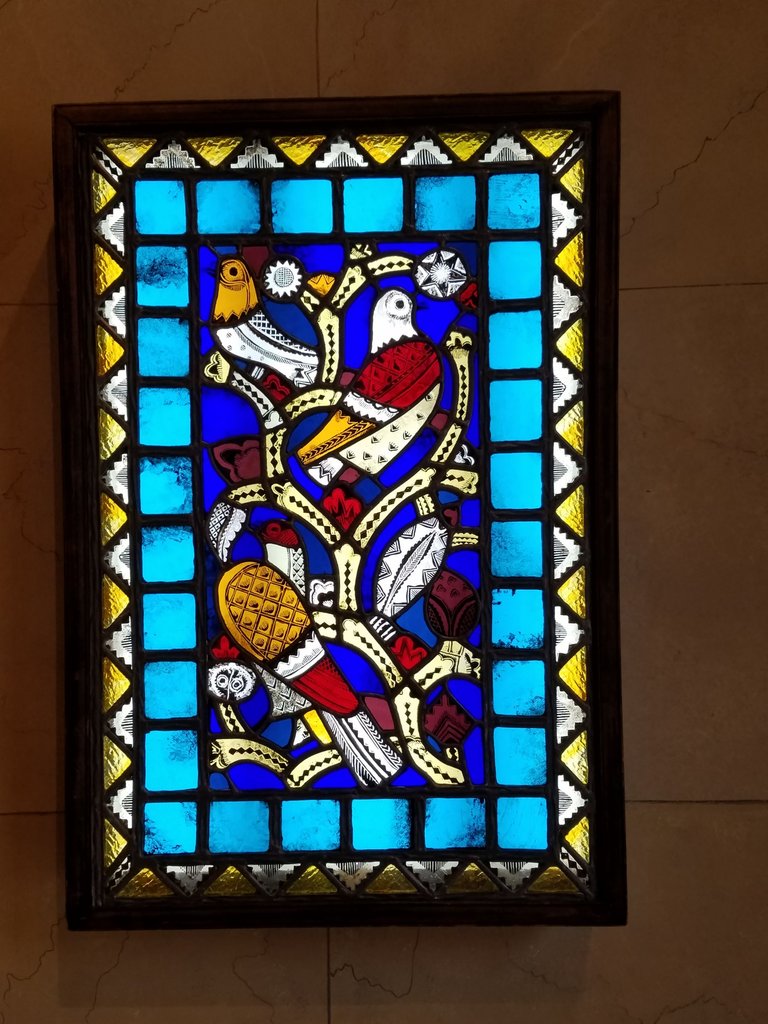
Chicago Stock Exchange Trading Room
Designed by Chicago architects Louis Sullivan and his partner, Dankmar Adler, the original Chicago Stock Exchange was completed in 1894. When it was demolished in 1972, sections of the Trading Room, including Sullivan’s elaborate stenciled decorations, molded plaster capitals, and art glass, were preserved and used in the 1976–77 reconstruction of the room here at the Art Institute. Today, the Stock Exchange Trading Room lends historic opulence to a wide variety of events, from wedding receptions to corporate gatherings.
This space is available to rent for special events:
https://www.artic.edu/venue-rental/event-spaces/chicago-stock-exchange-trading-room
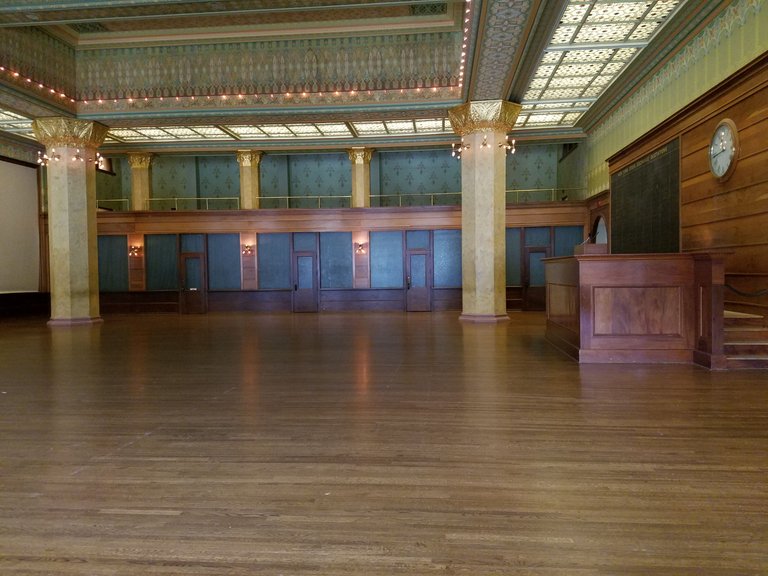
THORNE MINIATURE ROOMS
Let your imagination take over on this journey through the Thorne Rooms — miniature and, as generations of Art Institute visitors have found, wonderfully transporting.
Narcissa Niblack Thorne, the creator of the Thorne Rooms, herself had a vivid imagination. In the 1930s, she assembled a group of skilled artisans in Chicago to create a series of intricate rooms on the minute scale of 1:12. With these interiors, she wanted to present a visual history of interior design that was both accurate and inspiring. The result is two parts fantasy, one part history—each room a shoe box–sized stage set awaiting viewers’ characters and plots.
If you like the Thorne Miniature Rooms, you should also check out Colleen Moore's Fairy Castle at the Museum of Science and Industry.
E-10: English Dining Room of the Georgian Period, 1770-90, c. 1937
Designed by Narcissa Niblack Thorne
American, 1882 - 1966
The sixty-eight fascinating Thorne Miniature Rooms feature highlights from the history of interior design and decorative arts from the thirteenth century to 1940. These enchanting miniature stage sets were conceived by Mrs. James Ward Thorne of Chicago and constructed between 1934 and 1940 by master craftsmen according to her exacting specifications, on a scale of one inch to one foot. The harmonious elegance seen here is based on two dining rooms designed by Robert Adam, the successful eighteenth-century London architect whose precise and delicate interpretation of the antique (stimulated by then-recent excavations at Herculaneum and Pompeii) dictated English taste for a quarter of a century. To insure perfect conformity, Adam undertook the entire design of a house and every detail of its interior, hiring cabinetmakers to execute furniture that blended Neoclassical elements with current English forms. Instead of using wood and wallpaper, Adam carved low-relief ornament in plaster against painted panels in the style of Roman stuccos, as seen in this dining room. His furniture was often gilded in the Continental fashion, as is the side table in this room. The landscape over the table, painted by one of the many artists that Mrs. Thorne commissioned for the project, is in the style of Claude Lorrain.
Gift of Mrs. James Ward Thorne
1941.1195
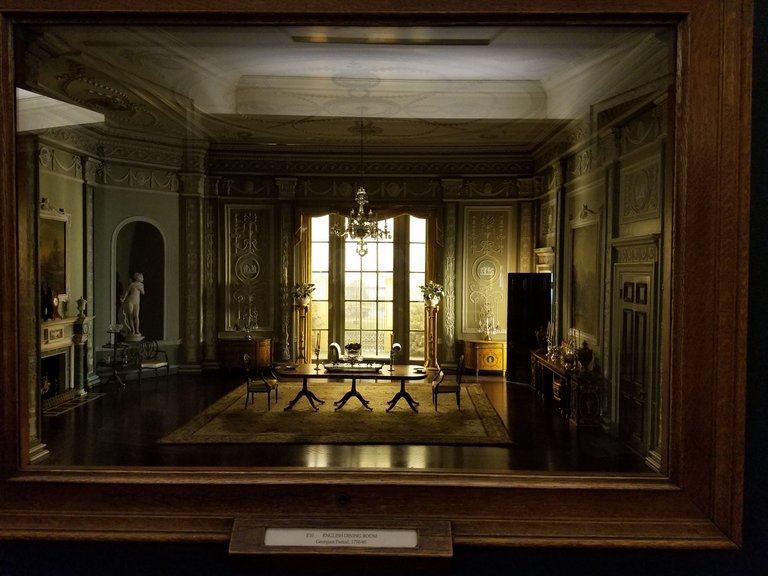
E-13: English Rotunda and Library of the Regency Period, 1810-20, c. 1937
Designed by Narcissa Niblack Thorne
American, 1882 - 1966
Gift of Mrs. James Ward Thorne
1941.1198

E-14: English Drawing Room of the Victorian Period, 1840-70, c. 1937
Designed by Narcissa Niblack Thorne
American, 1882 - 1966
Narcissa Thorne must have imagined the occupants of this miniature drawing room to be loyal subjects of the English Crown, as it abounds with images of Queen Victoria and her husband, Albert. Thorne was amused by the lavish decoration and heavy ornament of Victorian furniture, which by her time had become unfashionable. The many ornate objects in this room were cleverly constructed using a mix of faux and genuine luxury materials: the candelabras, for example, are painted to look like gold, whereas the bases of the lamps flanking the doorway are made from real ivory.
Gift of Mrs. James Ward Thorne
1941.1199
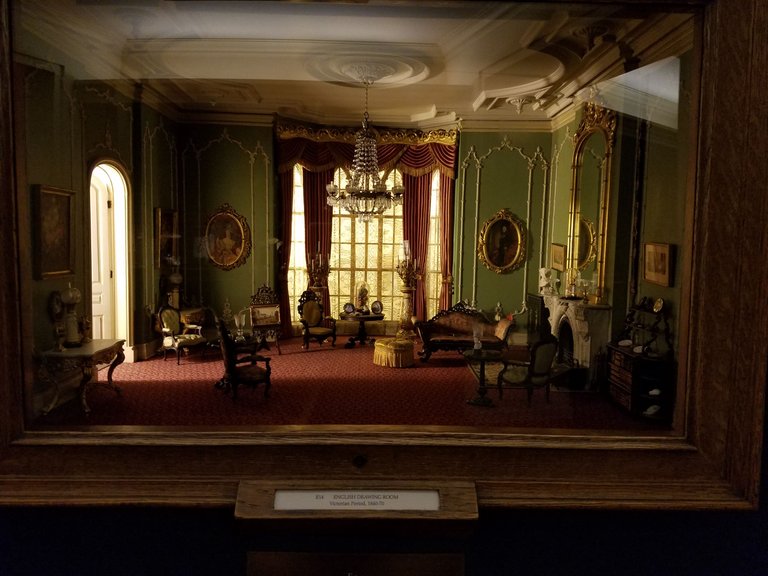
E-18: French Salon of the Louis XIV Period, 1660-1700, c. 1937
Designed by Narcissa Niblack Thorne
American, 1882 - 1966
Gift of Mrs. James Ward Thorne
1941.1203
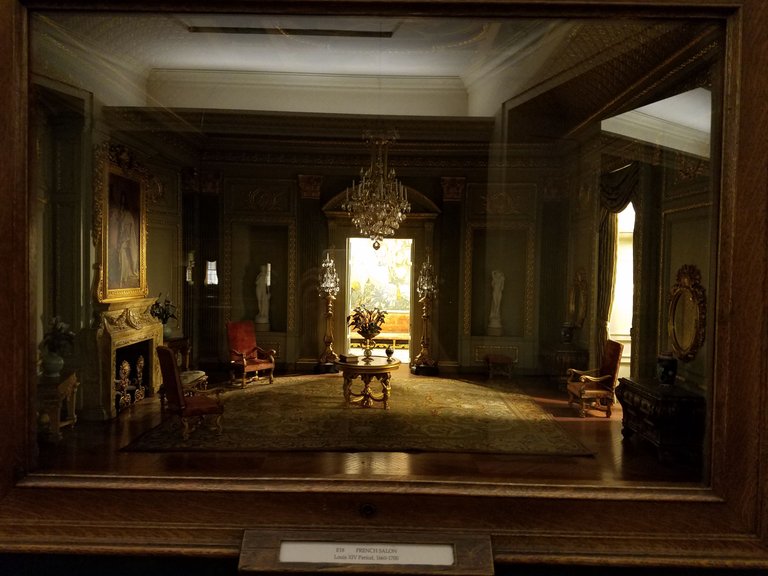
E-20: French Library of the Louis XV Period, c. 1720, c. 1937
Designed by Narcissa Niblack Thorne
American, 1882 - 1966
Gift of Mrs. James Ward Thorne
1941.1205

E-26: French Anteroom of the Empire Period, c. 1810, c. 1937
Designed by Narcissa Niblack Thorne
American, 1882 - 1966
Gift of Mrs. James Ward Thorne
1941.1211
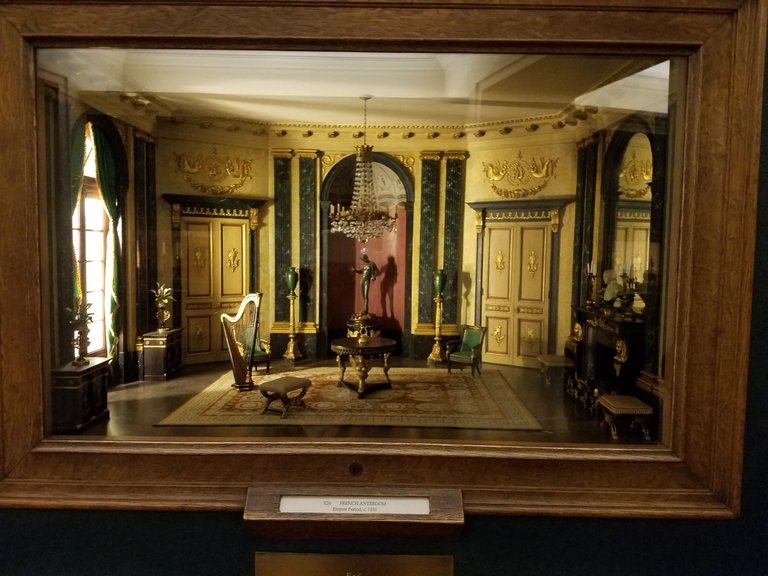
A29: South Carolina Ballroom, 1775-1835, c. 1940
Designed by Narcissa Niblack Thorne
American, 1882 - 1966
Gift of Mrs. James Ward Thorne
1942.509
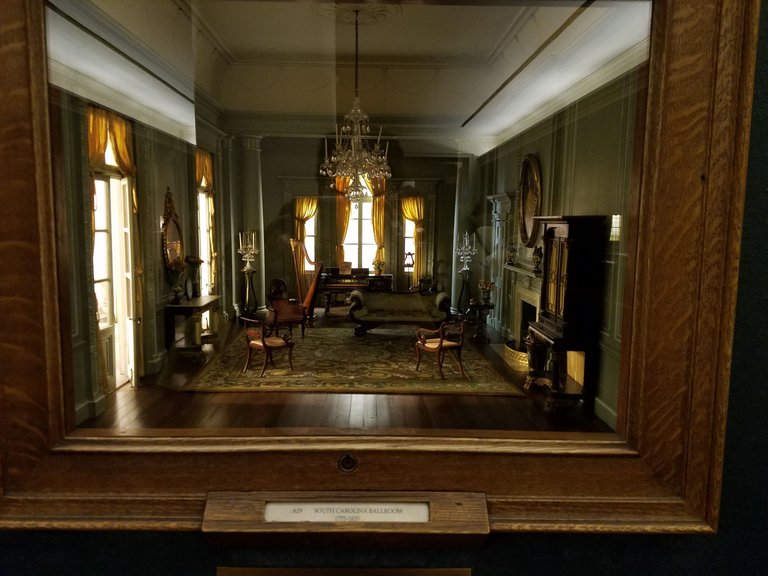
E-3: English Reception Room of the Jacobean Period, 1625-55, c. 1937
Designed by Narcissa Niblack Thorne
American, 1882 - 1966
In this English reception room of the Jacobean Period (1625-55) Italian Renaissance architecture and the contemporary fashion for Baroque ornamentation are the major influences. Here, Mrs. Thorne drew on two lavish rooms at Wilton, the magnificent house designed for Philip Herbert, fourth Earl of Pembroke.
Gift of Mrs. James Ward Thorne
1941.1188
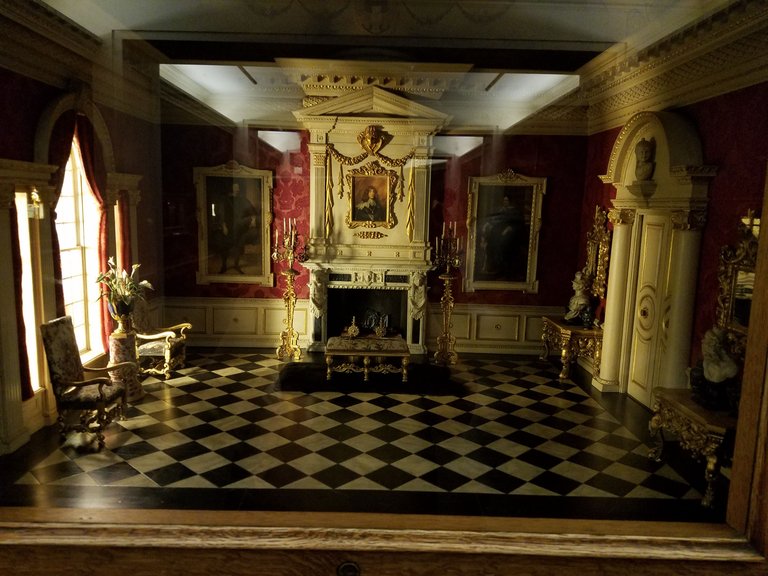
E-29: English Roman Catholic Church in the Gothic Style, 1275-1300, c. 1937
Designed by Narcissa Niblack Thorne
American, 1882 - 1966
Of the 68 rooms created by Thorne and her craftsmen, this is the only miniature of a sacred space. The Gothic-style church is built on an even smaller scale than the models of domestic spaces, emphasizing the grandeur of the space. Thorne did not set out to create a “typical” church space but rather one with specific character and exquisite details. She lavished attention on even the smallest elements of the space, specially commissioning the elaborate altarpiece, grille work, and crucifix from artists who generally worked in full scale. The Gothic style of the church would have been familiar to her Chicago viewers—after the Great Fire of 1871, the city embraced the Gothic Revival style for churches, universities, apartment buildings, hotels, and private clubs.
Gift of Mrs. James Ward Thorne
1941.1215
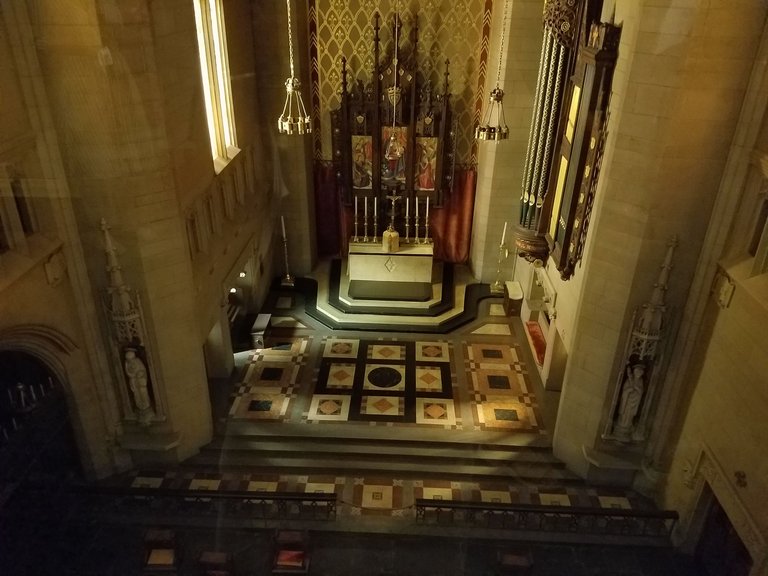
AMERICAN ART
Unfortunately my picture of Mary Cassatt's The Child’s Bath did not turn out.
American Gothic, 1930
Oil on Beaver Board
Grant Wood
American, 1891 – 1942
In American Gothic, Grant Wood directly evoked images of an earlier generation by featuring a farmer and his daughter posed stiffly and dressed as if they were, as the artist put it, “tintypes from my old family album.” They stand outside of their home, built in an 1880s style known as Carpenter Gothic. Wood had seen a similar farmhouse during a visit to Eldon, Iowa.
When it was exhibited at the Art Institute in 1930, the painting became an instant sensation, its ambiguity prompting viewers to speculate about the figures and their story. Many understood the work to be a satirical comment on midwesterners out of step with a modernizing world. Yet Wood intended it to convey a positive image of rural American values, offering a vision of reassurance at the beginning of the Great Depression.
Friends of American Art Collection
1930.934
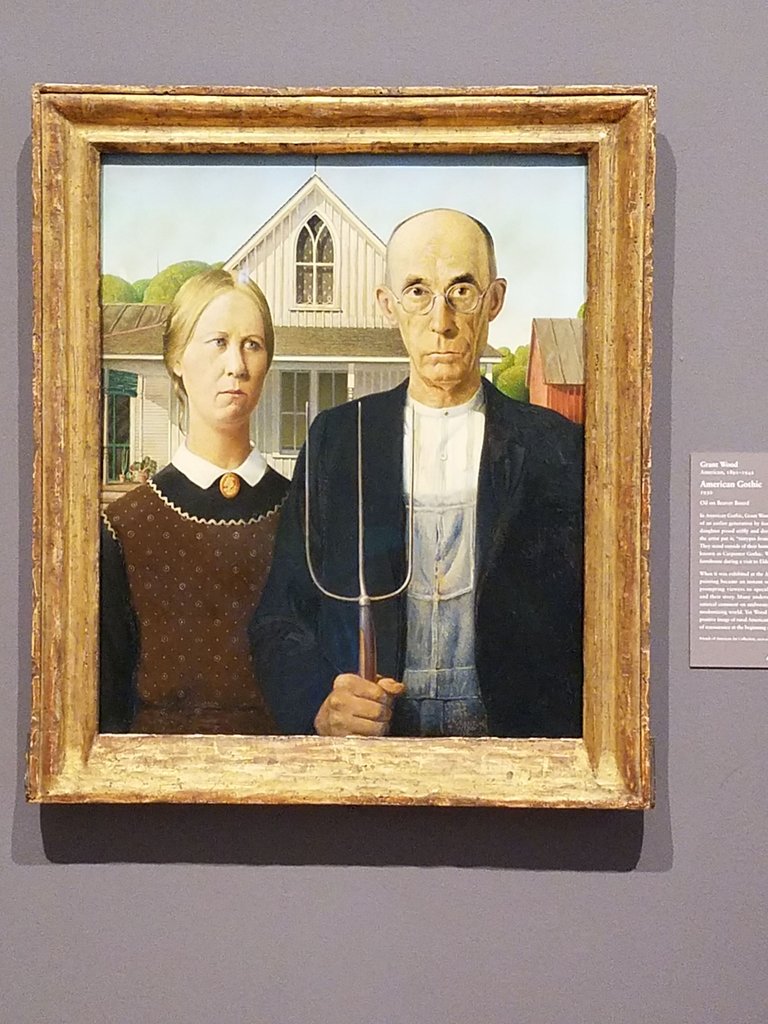
Nighthawks, 1942
Oil on canvas
Edward Hopper
American, 1882 – 1967
About Nighthawks Edward Hopper recollected, “unconsciously, probably, I was painting the loneliness of a large city.” In an all-night diner, three customers sit at the counter opposite a server, each appear to be lost in thought and disengaged from one another. The composition is tightly organized and spare in details: there is no entrance to the establishment, no debris on the streets. Through harmonious geometric forms and the glow of the diner’s electric lighting, Hopper created a serene, beautiful, yet enigmatic scene. Although inspired by a restaurant Hopper had seen on Greenwich Avenue in New York, the painting is not a realistic transcription of an actual place. As viewers, we are left to wonder about the figures, their relationships, and this imagined world.
Friends of American Art Collection
1942.51
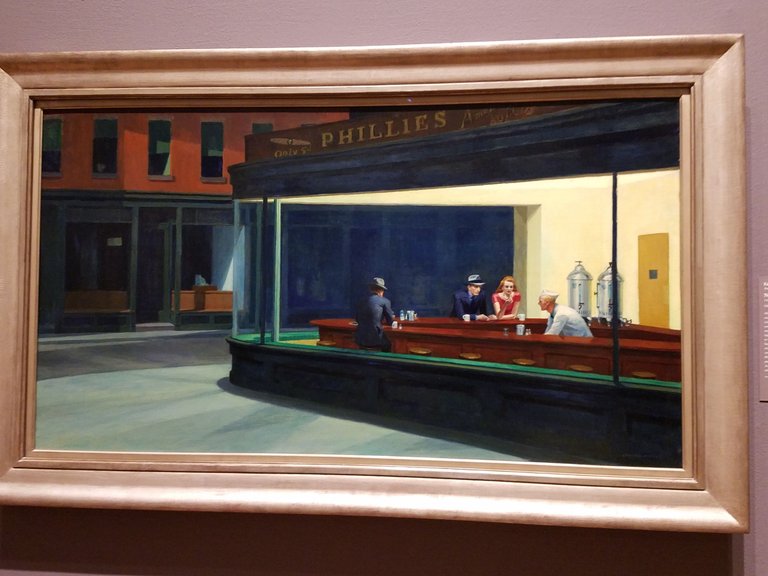
Sky above Clouds IV, 1965
Oil on canvas
Georgia O’Keeffe
American, 1887 – 1986
Painted in the summer of 1965, when Georgia O’Keeffe was 77 years old, this monumental work culminates a series inspired by the artist’s experiences as an airplane passenger during the 1950s. Working in Abiquiu, New Mexico, O’Keeffe began around 1963 to capture the endless expanses of clouds she had observed from airplane windows during trips all over the world. Beginning with a relatively realistic depiction of small white clouds on a three-by-four-foot canvas, she progressed to more stylized images of the motif on larger surfaces. O’Keeffe wrote:
“I painted a painting eight feet high and twenty-four feet wide—it kept me working every minute from six a.m. till eight or nine at night as I had to be finished before it was cold—I worked in the garage and it had no heat—Such a size is of course ridiculous but I had it in my head as something I wanted to do for a couple of years.”
In 1970 Sky above Clouds IV was scheduled to be included in a retrospective of O’Keeffe’s work at the Whitney Museum of American Art, New York, the Art Institute of Chicago, and the San Francisco Museum of Art. After being shown in New York and Chicago, the painting was determined to be too large to enter the doors of the museum in San Francisco. It thus remained on loan to the Art Institute for more than a decade, while the artist and public-minded collectors of her art arranged for it to join the museum’s permanent collection.
The special relationship between O’Keeffe and the Art Institute began in 1905, when she enrolled as a student at the School of the Art Institute. Her first museum retrospective was organized here in 1943. Later, as the executor for the estate of her husband, the pioneering American photographer and art dealer Alfred Stieglitz, O’Keeffe presented the Art Institute with an important group of modernist works, including a number of her own, many of which are on view in the galleries of American art. She continued to make significant additions to this bequest until her death, at age 98, in 1986.
Purchased with funds provided by the Paul and Gabriella Rosenbaum Foundation; gift of Georgia O'Keeffe
1983.821
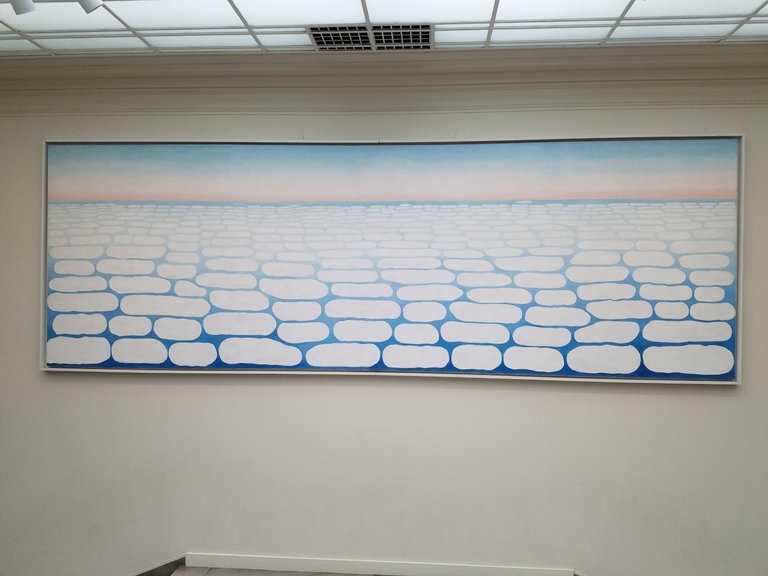
Mrs. George Swinton (Elizabeth Ebsworth), 1897
Oil on canvas
John Singer Sargent
American, 1856 – 1925
Mrs. George Swinton epitomizes the painterly virtuosity that made John Singer Sargent one of the most fashionable portraitists in late-19th-century Europe and America. Extravagant color and brushwork were central to Sargent’s success, as was his ability to present a refined and appealing image of his sitter. In Elizabeth “Elsie” Swinton’s case, he accentuated her regal bearing and feminine dress. Sargent harmonized the realism of her face and body with bursts of impressionistic brushstrokes describing the shimmering, translucent fabric descending from her shoulder. Swinton was also known for her musical talents; at the time her portrait was executed, she was recognized as an amateur singer and later began performing professionally.
Wirt D. Walker Collection
1922.4450
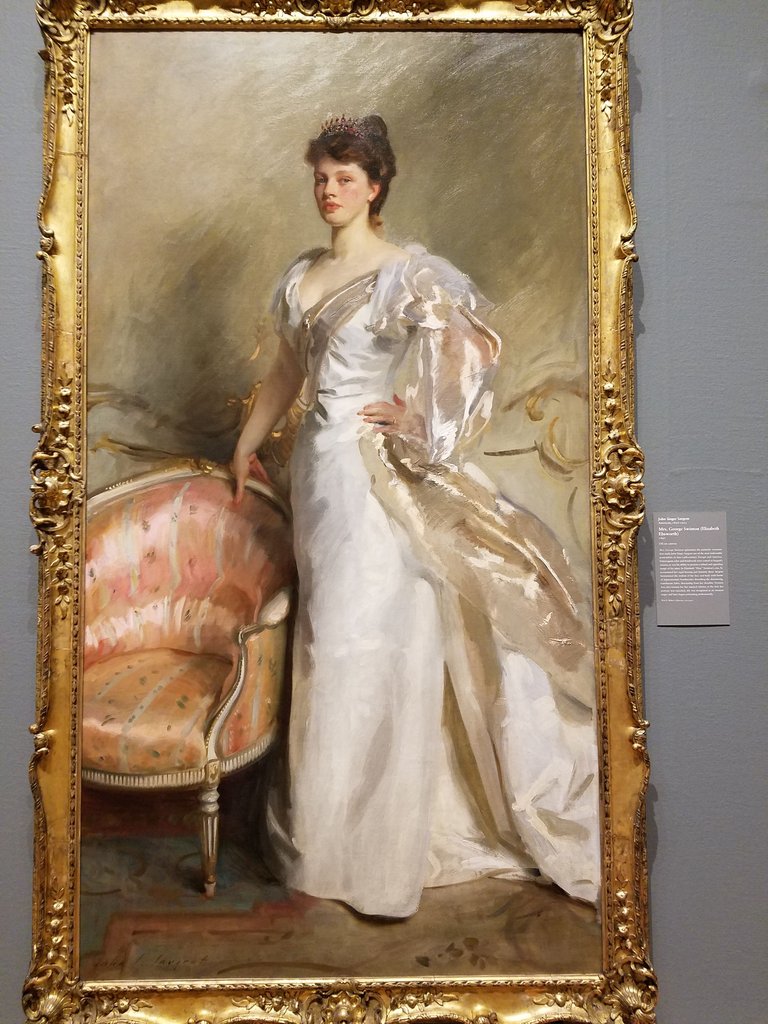
Zenobia, Queen of Palmyra, modeled c. 1859; carved after 1859
Marble
Harriet Hosmer
American, 1830 – 1908
Zenobia was queen of the Syrian city of Palmyra and ruled it after her husband’s death in the third century. Harriet Hosmer portrayed Zenobia at the moment of her capture and defeat by the Roman emperor Aurelian in 272 CE. Rather than depict a scene of heightened drama, the sculp-tor opted for a quieter sense of grandeur, remarking, “I have tried to make her too proud to exhibit passion or emotion of any kind; not subdued, though a prisoner; but calm, grand, and strong within herself.”
Hosmer was the leader of a group of women sculptors in Rome beginning in the 1850s. Many of her works feature strong, independent women drawn from history or literature.
Purchased with funds provided by the Antiquarian Society
1993.260
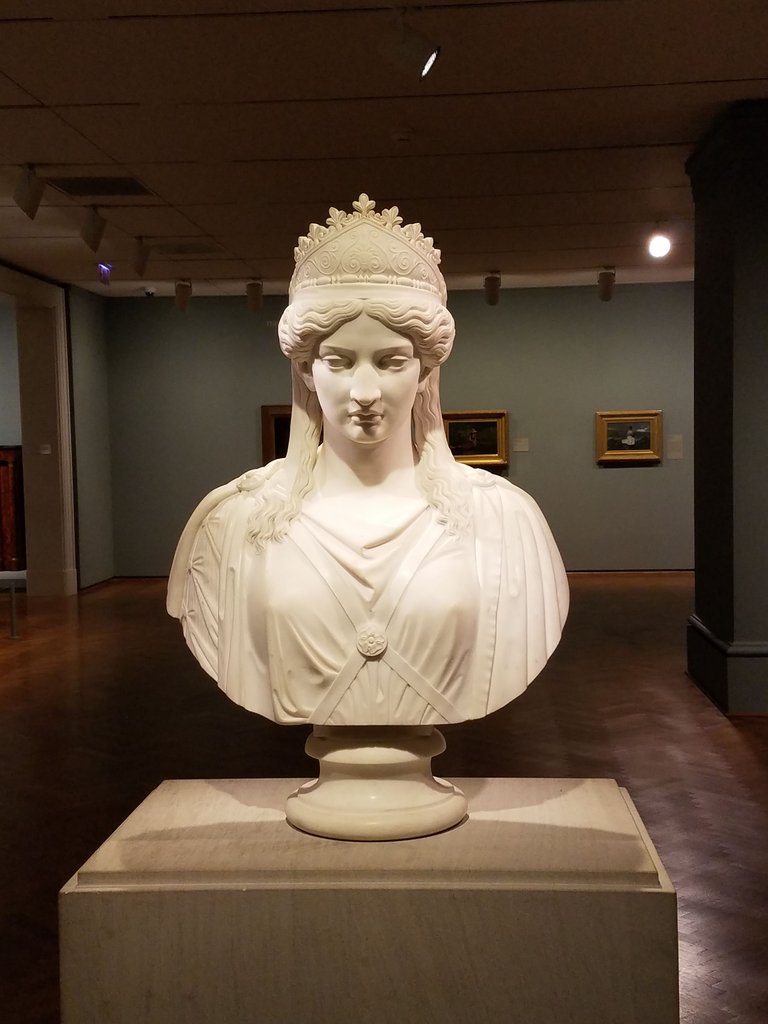
Miss Expanding Universe, 1932
Aluminum
Isamu Noguchi
American, 1904 - 1988
Born in the United States, Isamu Noguchi lived in Japan until he was 13 years old and was deeply affected by Japanese art and culture. In 1930 the artist returned to Japan to study its sculptural traditions and ceramics. Miss Expanding Universe was the first sculpture Noguchi made upon his return to the United States in 1932. In this work, he combined machine-age streamlining with characteristics of ancient Japanese funerary sculpture (haniwa). Later the same year, Noguchi transformed this flowing form into a sacklike costume for the pioneering dancer and choreographer Ruth Page and her ballet Expanding Universe.
Bequest of Ruth Page
1994.833
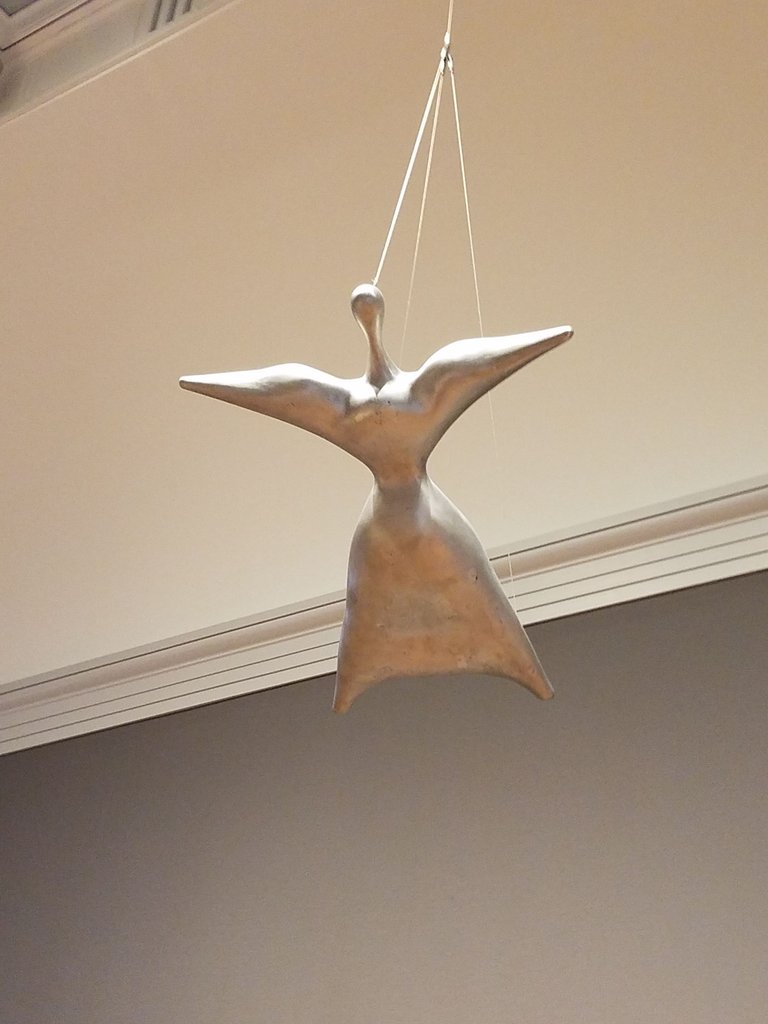
View of Cotopaxi, 1857
Oil on canvas
Frederic Edwin Church
American, 1826 – 1900
View of Cotopaxi brings together in visual form scientific, religious, political, and cultural ideas in the mid-19th century. Inspired by German naturalist Alexander von Humboldt’s concept of ecological interconnectedness, Frederic Edwin Church traveled to South America to meticulously study the tropical landscape. The artist produced at least ten finished paintings of the Ecuadorian volcano, this one completed in his studio just before his second visit to the region. For Church and other Christian viewers, nature, with all its creative and destructive wonders, was evidence of divine power. The painting likewise reflected an imperialist vision, as US government officials eyed Latin America as a site for territorial expansion and conquest.
Gift of Jennette Hamlin in memory of Mr. and Mrs. Louis Dana Webster
1919.753
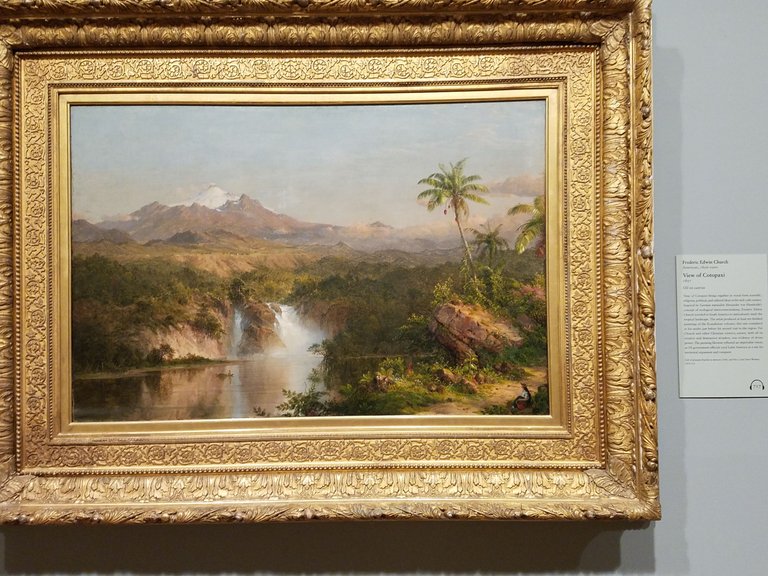
Distant View of Niagara Falls, 1830
Oil on panel
Thomas Cole
American, born England, 1801 – 1848
Thomas Cole visited Niagara Falls in May 1829, composing this romanticized, autumnal scene the following year. Portraying the grandeur of the American landscape, the artist omitted the factories, scenic overlooks, and hotels that populated the area in the early 19th century. Cole expressed concern about the environmental impact of voracious industrialism, but at the same time his painting erased the human devastation wrought by colonialism and conquest in the region, which encompassed Attiwonderonk, Haudenosaunee, and Wenrohronon lands. The two Native American figures at center, combined with the falls, identify the setting as North America, but their diminished presence in scale and number reinforces the false idea of the “vanishing Indian” and is meant to signal impending transformation rather than acknowledge their stolen sovereignty.
Friends of American Art Collection
1946.396
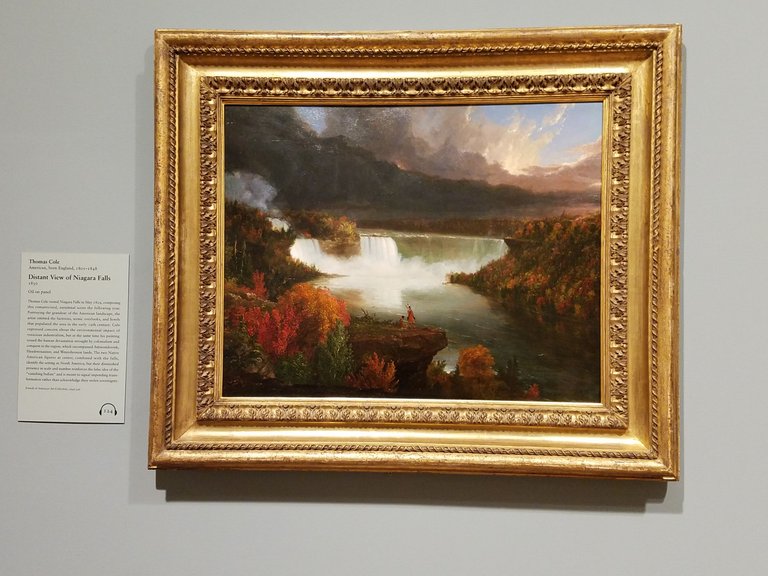
A Marine, c. 1874 – 75
Oil on canvas
George Inness
American, 1825 – 1894
George Inness’s rough, energetic brushstrokes evoke the raw beauty and potentially destructive power of the ocean in this dramatic seascape. He created it during a trip to Europe in the early 1870s. It was previously thought to depict Étretat, in Normandy, France, but scholars now believe that the image is of Porto d’Anzio, Italy. The sky is illuminated by patches of orange and white light, outlining the ships and distant town on the horizon. Careful study of the surface of the central rock in the foreground illustrates the artist’s impressive manipulation of paint: by employing shifts in texture and shading, he was able to emphasize distinctions between sun and shadow, wet and dry, and clean and algae-covered. Inness traveled to Europe to study landscape painting with the masters of the Barbizon School, who were known for a personal style that contrasted with the grandiose Hudson River School in America. The influence of this intimate approach is apparent in the painting of the rocks and spraying seawater.
Edward B. Butler Collection
1913.90
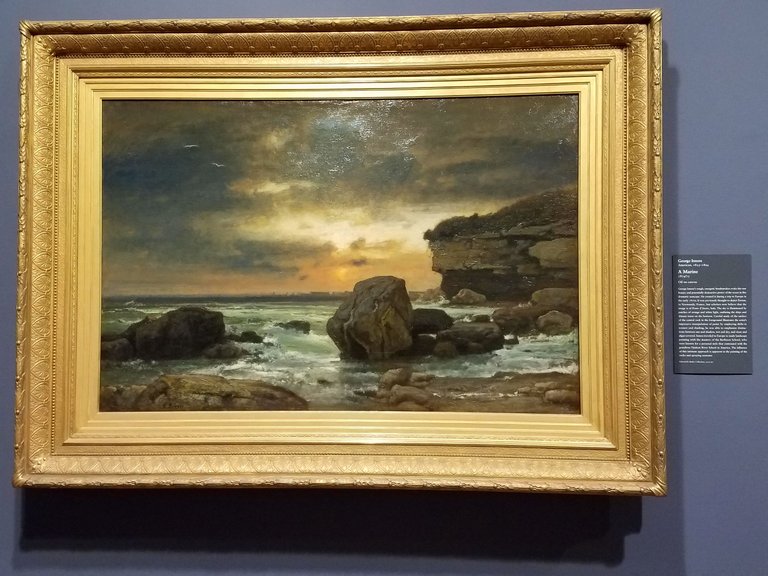
MODERN ART
Golden Bird, 1919 / 20 (base c. 1922)
Bronze, stone, and wood
Constantin Brancusi
Romanian, active France, 1876 – 1957
Trained in both folk and academic traditions, Constantin Brancusi sought his own path for sculpture around 1907. Breaking with the currents of the time, he adopted direct carving, combined different materials for single works, and simplified form in his search for his subjects’ essential characters. His works have profoundly influenced the development of twentieth-century abstraction.
More than any other theme, Brancusi’s series Bird summarizes his quest for a self-sufficient form. “All my life, I have sought to render the essence of flight,” the artist once said. He began the first of twenty-seven Bird sculptures around 1910 and completed the last in the 1940s. He called the earliest variations Maiastra, referring to a bird in Romanian folklore that leads a prince to his princess. In the Art Institute’s Golden Bird, details such as feet, a tail, and an upturned crowing beak are only suggested in an elegant, streamlined silhouette. Brâncusi perched this refined shape on a rough-hewn, geometric base, contrasting the disembodied, light-reflective surface with an earthbound mass. The central polyhedron was cut from the middle of a tree trunk, and its circles (indicating the tree’s age) rotate like a sun, as if radiating light over the bird.
Partial gift of The Arts Club of Chicago; purchased with funds provided by various donors.
1990.88
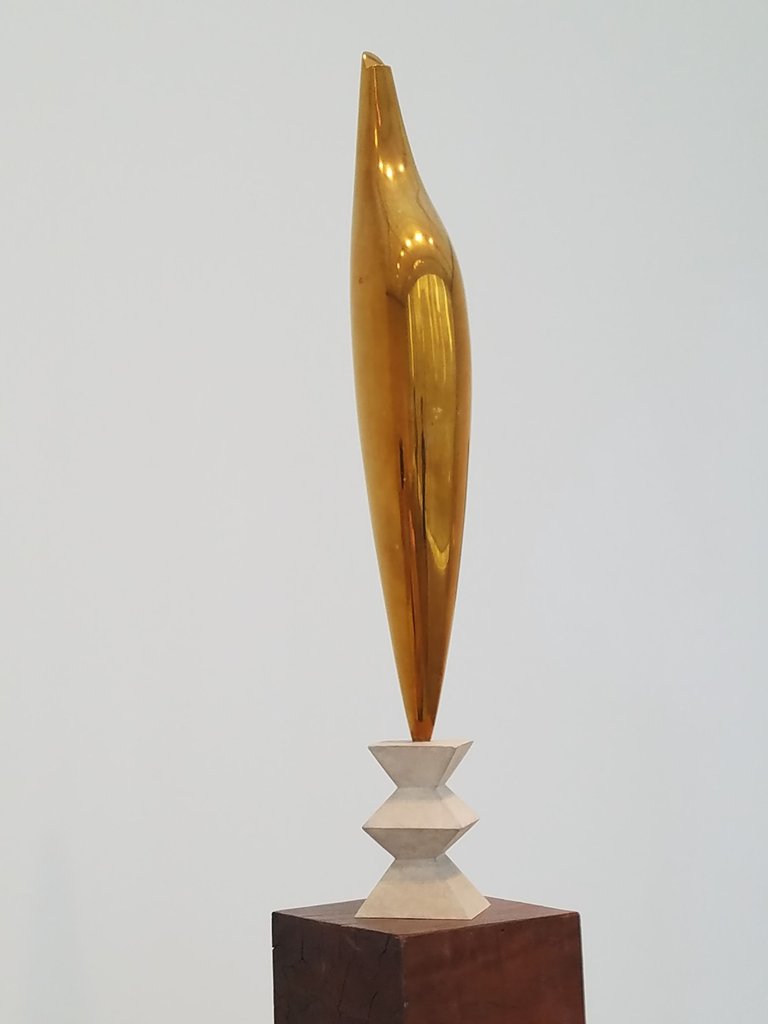
White Negress, 1928
White marble, black marble, stone, and wood
Constantin Brancusi
Romanian, active France, 1876 – 1957
Among sculptors of his generation in Europe, Constantin Brancusi was arguably the most influenced by African art in his choices of materials and forms, but it was not until the middle of his career, in the 1920s and 1930s, that he chose to represent his impression of an African subject in two related series: White Negress and Blond Negress. According to the artist, the impetus for these works was a visit to the 1922 Colonial Exposition—an expansive exhibition demonstrating France’s dominance as a colonial power held in Marseille—where he observed a woman he understood to be of African descent. The anonymous subject, rendered as an elongated volume with just two features, lips and hair, reflected European stereotypes about African physiognomy, and presented the paradox of seeing a black body represented in light-colored materials. White in the title refers to the color of the marble, which at once relates to the tradition of marble statuary but also to an ongoing 20th-century fetishism of black bodies. In the blond versions, this same form appears in highly polished, mirror-like bronze.
Grant J. Pick Collection
1966.4
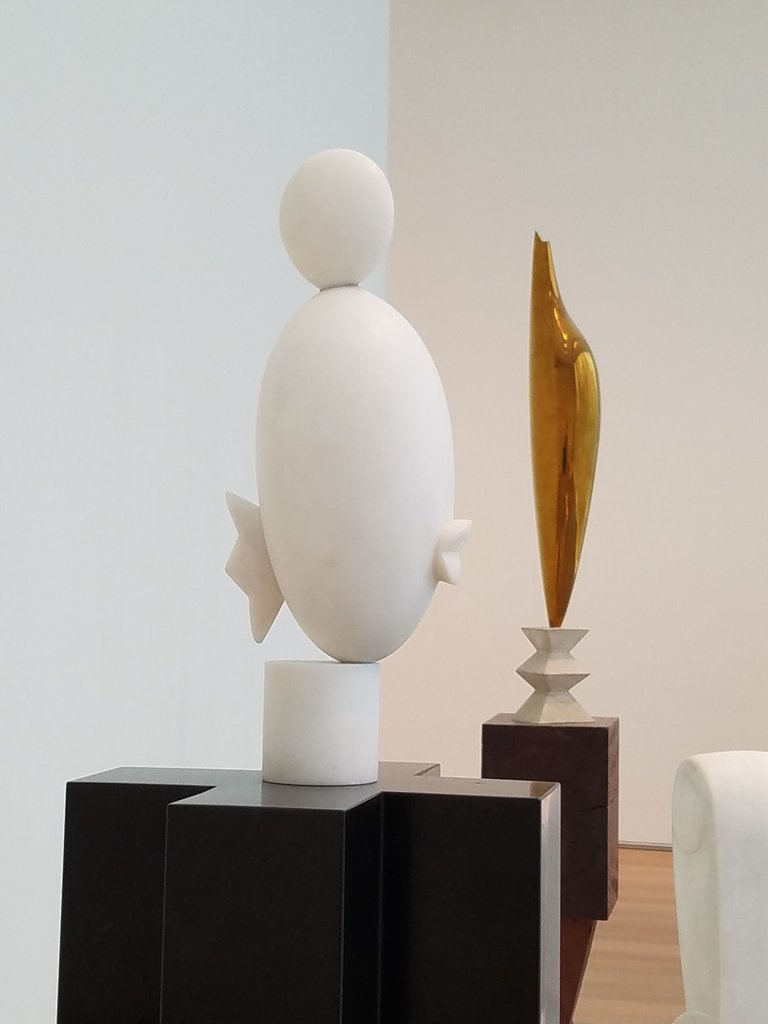
Two Penguins, 1911 / 1914
Marble
Constantin Brancusi
Romanian, active France, 1876 – 1957
Ada Turnbull Hertle Fund
1961.1115
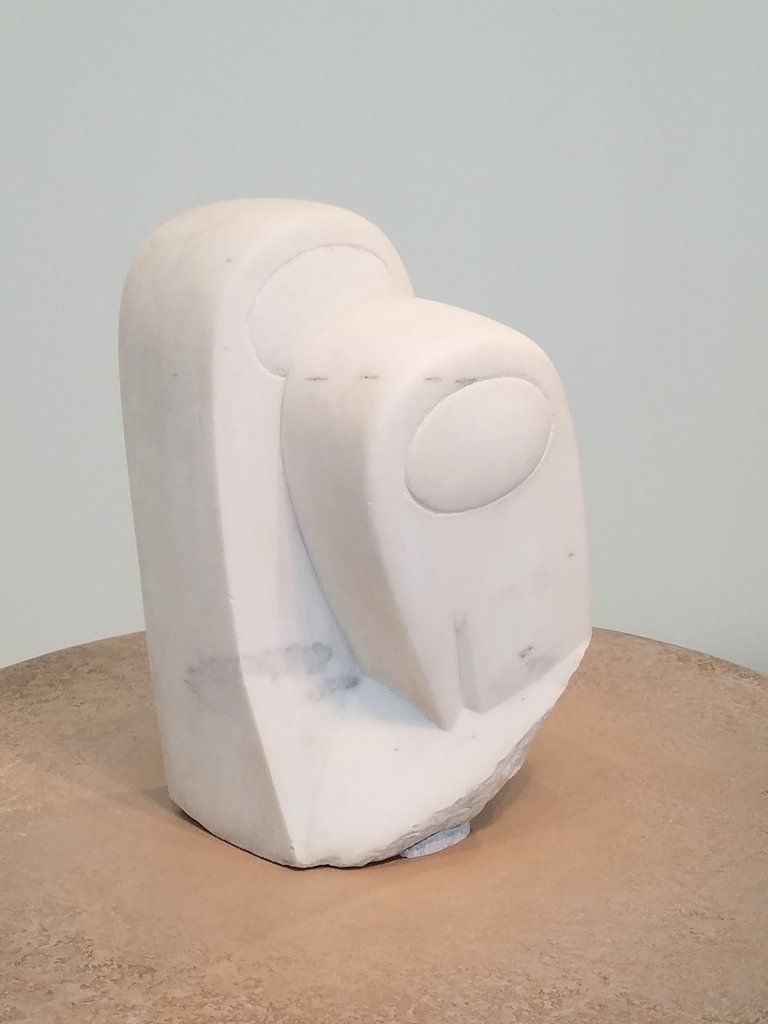
On the Threshold of Liberty , February – March 1937
Oil on canvas
René Magritte
Belgian, 1898 – 1967
One of Surrealism’s most important patrons, Edward James was a willing collaborator whose sense of play initiated commissions for his homes from such artists as René Magritte and Salvador Dalí, including the latter’s iconic lobster telephone and Mae West lips sofa. James was impressed with Magritte’s work in the 1936 International Surrealist Exhibition in London and invited the artist to paint three canvases for his London home. Magritte made On the Threshold of Liberty during his stay there in 1937, reworking the motif of a cannon aimed at a female torso from an earlier horizontal painting of the same title (now in the Museum Boijmans Van Beuningen, Rotterdam) into a vertical format in order to meet the specifications of the work’s destined site in James’s ballroom.
Gift of Mary and Leigh Block
1988.141.10
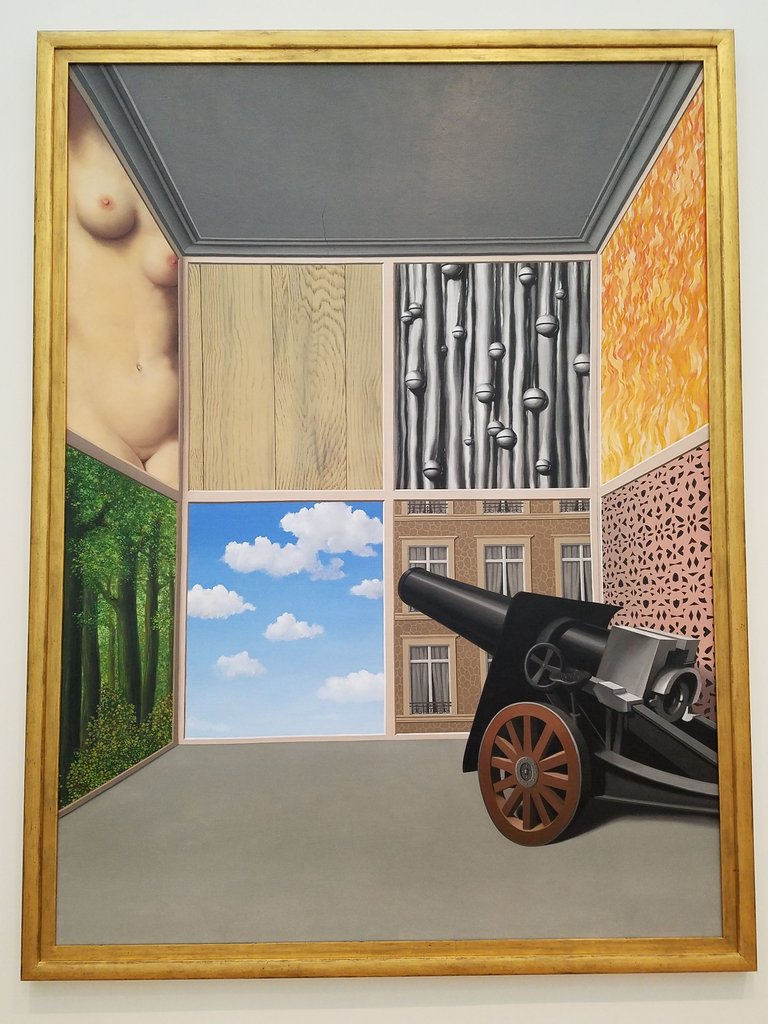
Bourgeois Bust- Jeff and Ilona, 1991
Marble
Jeff Koons
American, born 1955
Jeff Koons originally made this work for his now notorious Made in Heaven exhibition, in which he explored concepts of love by referencing his own marriage to Italian porn star Ilona Staller. He explains, “With Bourgeois Bust, I wanted … to be able to bring Ilona’s body and my body down together in a point so that it’s a heart—a symbol of love—and take the flesh and cut through it to form it that way without any sense of violence.” Here the couple appears within a traditional Baroquestyle portrait bust like those of 18th-century sculptor Antonio Canova (whose work you can see in the museum’s galleries of European painting and sculpture). Bourgeois Bust sets in tension the elegance of neoclassical sculpture and the irreverence of deploying its idealized terms in the postmodern era.
Gift of Edlis Neeson Collection
2015.141
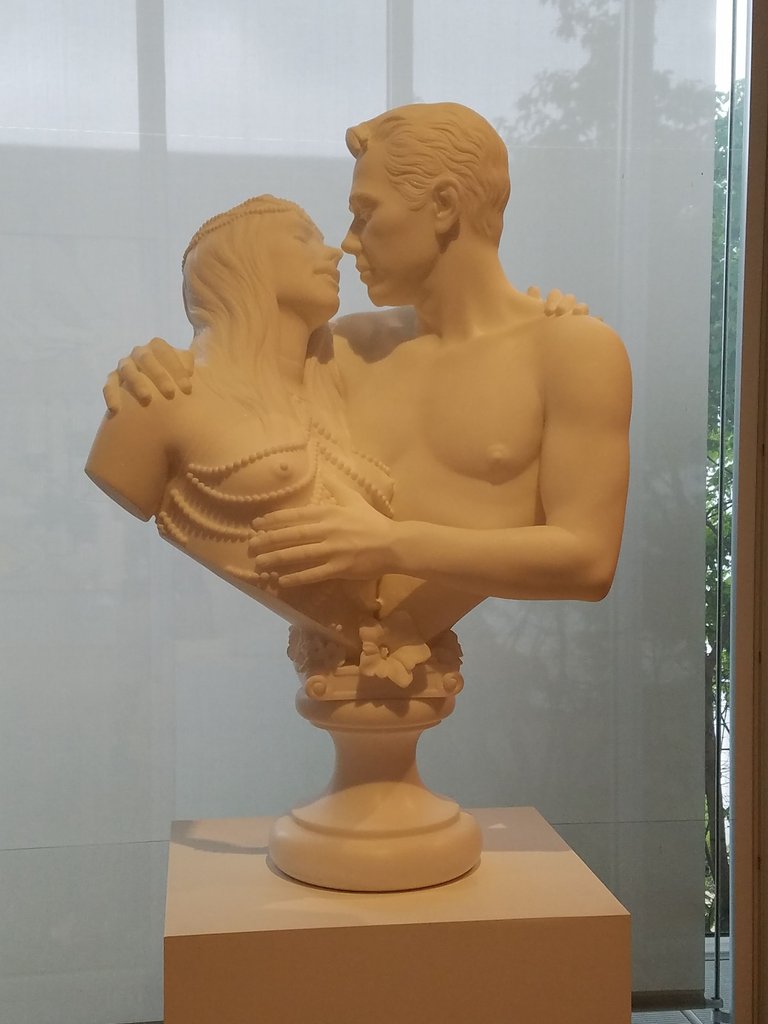
Christ and the Lamb, 1988
Gilded wood and mirror
Jeff Koons
American, born 1955
Having turned to art after a brief stint as a Wall Street commodities trader, Jeff Koons creates beautifully crafted and often controversial sculptures. An elaborate, Rococostyle mirror, Christ and the Lambis also a visual puzzle: its frame shapes the mirror surface into the figure of the infant Jesus playing with a lamb, taken from Leonardo da Vinci’s famous painting The Virgin and Child with Saint Anne (1508; Musée du Louvre, Paris). Viewers thus see their own image superimposed on the body of the Christ Child. Koons has said, “Anything that reflects has a kind of spiritual transcendence because it involves the viewer. It acknowledges your presence. Every time you move, the reflection changes; it always acknowledges you.”
Gift of Edlis Neeson Collection
2015.140
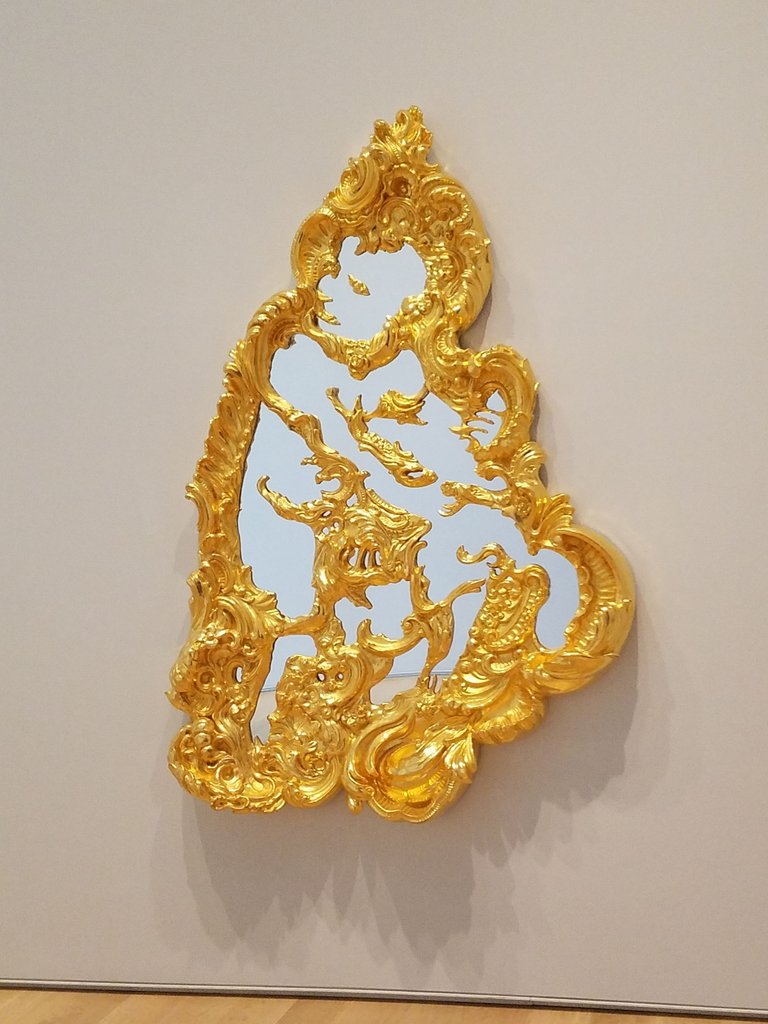
Woman with Dog (Frau mit Hund), 2004
Polyester, iron, wood, and paint
Katharina Fritsch
German, born 1956
Katharina Fritsch makes meticulous reproductions of everyday objects, rendering them unfamiliar through extreme shifts in scale and either alluring or repellent color choices. Indeed, saturated and nonreflective coats of color lend her sculptures a strong sense of otherworldliness. “I always call the starting point [for a sculpture] a vision,” she has said. “I’ll be in a tram or driving a car and I suddenly get a picture in my mind. Something completely normal turns into a miracle—something I’ve never seen before. Simple things you see every day turn into something strange, something alien.” Woman with Dog is clearly scaled up— enormously so—from a small figurine made of shells, as one might find in a seaside souvenir shop.
Gift of Edlis Neeson Collection
2015.144
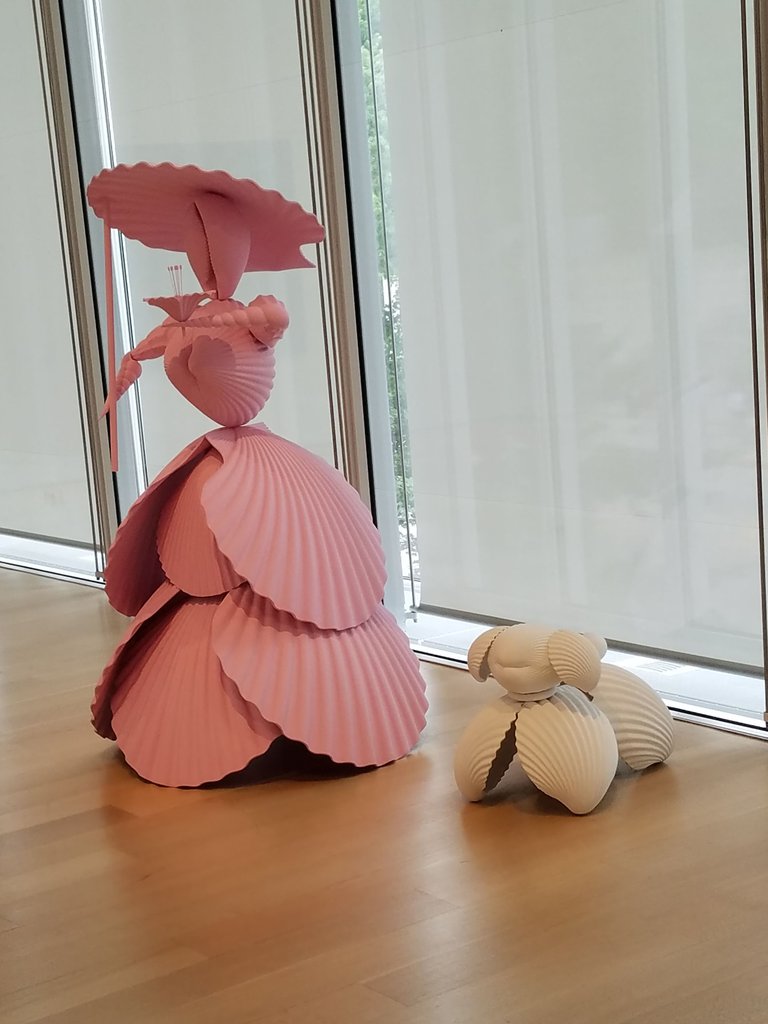
Naturaleza mesa viva (Nature living table), 1971
Enamel on metal, on metal table
Beatriz González
Colombian, born 1932
Entranced by the faux wood grain of a metal table she encountered at a market in Bogota, Beatriz Gonzalez commissioned a replica to serve as the support for this work. The artist then created an enamel-on-metal painting for the tabletop, basing the kittens and fishbowl on a print mass-produced by the Columbian company Graficas Molinari for a consumer audience. The title is a play on the Spanish term for still life, naturaleza muerta. Gonzalez eventually stopped creating furniture work "because people started to like it."
Courtesy of the artist
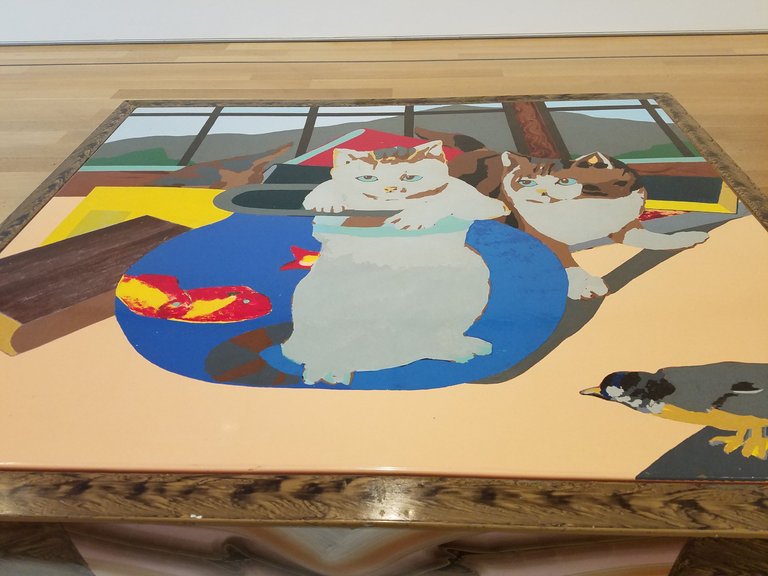
Untitled #92, 1981
Chromogenic print
Cindy Sherman
American, born 1954
Cindy Sherman is a major figure in the contemporary revival of directed, or staged, photography. Her work explores the pervasive effects that mass-media images have upon the construction, assumption, and projection of individual identities. Since the late 1970s, the artist has served as both photographer and model for a large cast of fictional personalities created through changes in costume, hair (usually a wig), makeup, and lighting. Sherman first gained recognition for a series of black-and-white works that imitate the look and feel of stills from popular films of the 1950s and 1960s. In 1981 she began a series of large color photographs that mimic the horizontal format of a magazine centerfold. Though formally reminiscent of such glossy spreads, Sherman’s representations are fraught with anxiety, vulnerability, and longing. In Untitled #92, she depicted herself in a moment of cinematic distress, crouched on the floor with wet hair. Her costume—white blouse and plaid skirt—evokes a school uniform, and her well-manicured hands offer evidence of some unknown struggle. An imposing darkness surrounds her but a bright light, suggestive of a flashlight or the headlights of a car, illuminates her blank expression.
Gift of Edlis Neeson Collection
2015.157
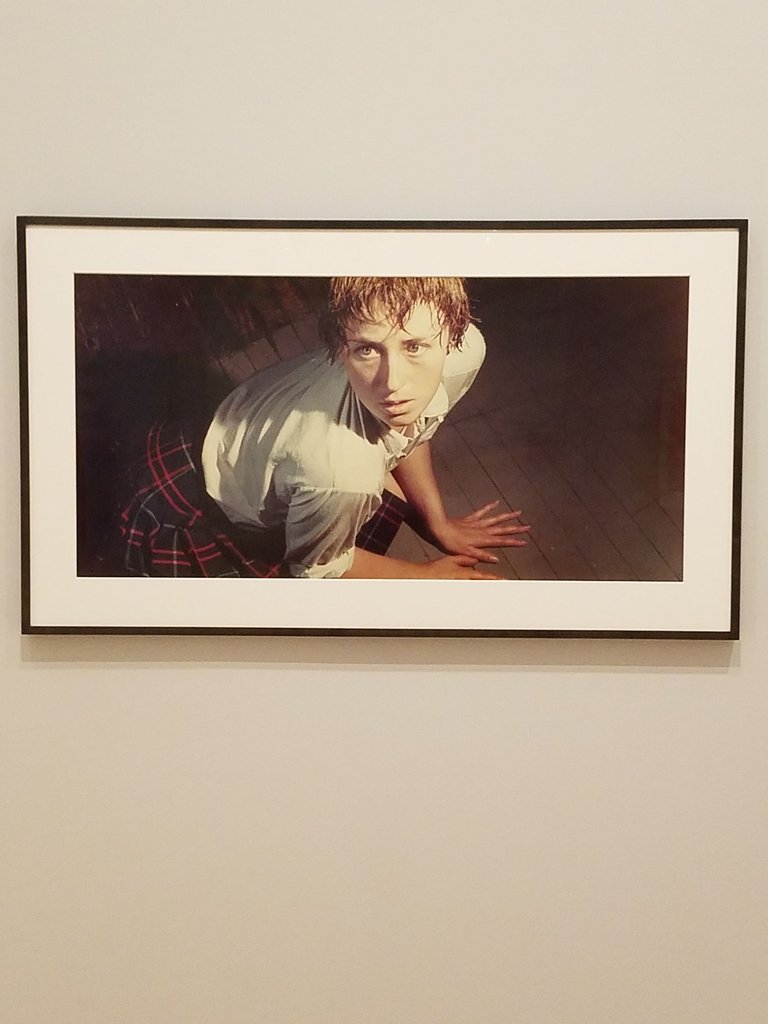
Untitled #93, 1981
Untitled #86, 1981
Chromogenic print
Cindy Sherman
American, born 1954
Gift of Edlis Neeson Collection
2015.158
2015.154

Relief no. 12B, 1936
Masonite, wood, cellulose acetate rods, plastic sheet, metal, brass, paint
César Domela
Dutch, 1900-1992
Among César Domela’s most ambitious “neoplastic reliefs,” Relief no. 12B is notable not only for its large size but also for its complex construction from overlapping hollow and solid disks. One of the youngest members of the Dutch art movement De Stijl, Domela made his first relief in 1929, using wood, metallic paint, and metal rods to create three-dimensional rectangular compositions that resemble geometric paintings yet extend into the space of the viewer by projecting off the wall. When Plexiglas was invented in 1933, Domela became one of the first artists to embrace it as a material, using it and other plastics to enhance the play of light within his works, and generate new physical and optical textures and patterns.
Gift of Lisa Goldberg in memory of Lillian Florsheim
Obj: 261219
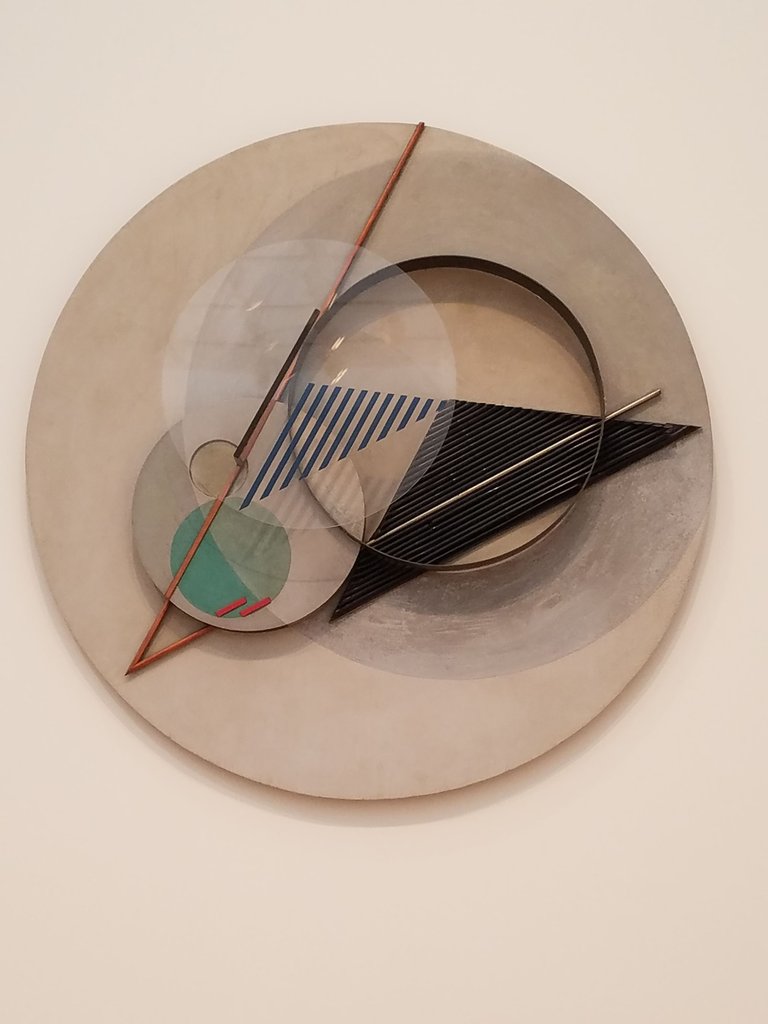
Untitled, 1974
Acrylic on Masonite
Christina Ramberg
American, 1946 - 1995

Clown Torture, 1987
Four-channel video installation with 2 projections and 4 monitors, color, sound; approx. one hour
Bruce Nauman
American, born 1941
Bruce Nauman’s wildly influential, relentlessly imitated work explores the poetics of confusion, anxiety, boredom, entrapment, and failure. One of the artist’s most spectacular achievements to date, Clown Torture consists of two rectangular pedestals, each supporting two pairs of stacked color monitors; two large color-video projections on two facing walls; and sound from all six video displays. The monitors play four narrative sequences in perpetual loops, each chronicling an absurd misadventure of a clown (played to brilliant effect by the actor Walter Stevens). In “No, No, No, No (Walter),” the clown incessantly screams the word no while jumping, kicking, or lying down; in “Clown with Goldfish,” the clown struggles to balance a fish bowl on the ceiling with the handle of a broom; in “Clown with Water Bucket,” the clown repeatedly opens a door booby-trapped with a bucket of water that falls on his head; and finally, in “Pete and Repeat,” the clown succumbs to the terror of a seemingly inescapable nursery rhyme. The simultaneous presentation and the relentless repetition creates an almost painful sensory overload. With both clown and viewer locked in an endless loop of failure and degradation, the humor soon turns to horror.
1997.162
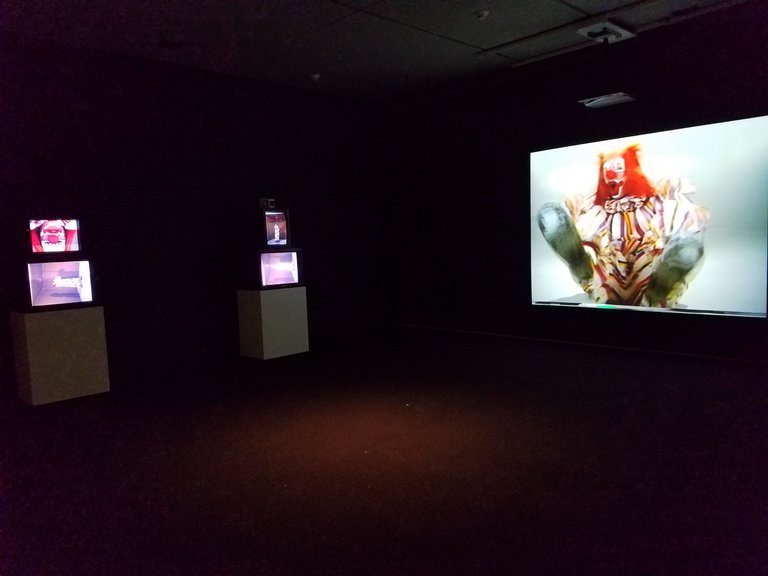
ARTS OF ASIA, CHINA, JAPAN, AND KOREA
Completed in 1992, the Ando Gallery (Gallery 109) evokes a traditional Japanese interior with 16 free-standing wood columns in a darkened room, framing the art objects displayed in cases around the room’s perimeter in an entirely modern way.
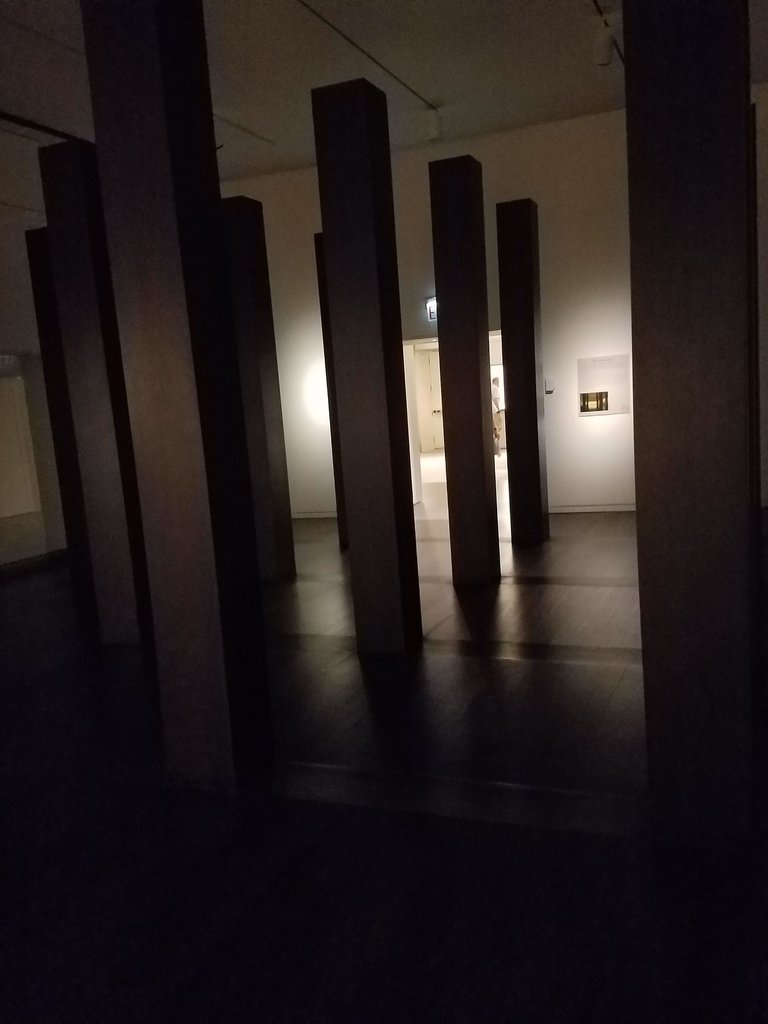
Mount Fuji and the Miho Pine Forest, c. 1761 - 1762
Pair of six panel screens; ink and light colors on paper
Soga Shōhaku 曾我 蕭白
Japanese, 1730 - 1781
The pair of folding screens is by one of the best known painters in Japan, Soga Shōhaku, revered for his unusual subjects and eccentric painting style. The iconic subject of Mount Fuji is here paired with the rising dragon, a rare and early expression of this auspicious subject and the earliest known large-scale version of this theme.
Shōhaku’s unparalleled technical skills with ink painting, and his irreverence with traditional norms, are on full display in this work. Ink paintings, having no way to distinguish texture, color, light and shadow other than with different applications of monochrome ink, are regarded as the peak of artistic accomplishment in East Asia. Here, Shōhaku is adept at describing lush trees, craggy rocks, and a snow-covered mountain, but also intangible aspects such as wind, rain, and clouds. Mount Fuji itself is painted in the negative with the white of the paper expressing the snow-covered mountain whose contours are created with layers of ink wash surrounding it. Reading from right to left, the landscape begins calm with a view of the bay and distant hills, until one encounters the rising dragon encased in clouds who is kicking up the wind and rain, affecting the boats on the water. In his wake, the dragon leaves behind a turbulent atmosphere with dark clouds surrounding Fuji. Within the landscape, all four seasons are depicted, from spring’s blossoming cherry trees to the deep snow of winter, and there is even a glimpse of the famous Tōkaidō road.
Through prior gift of Mr. and Mrs. Samuel M. Nickerson
2023.3068.2
2023.3068.1
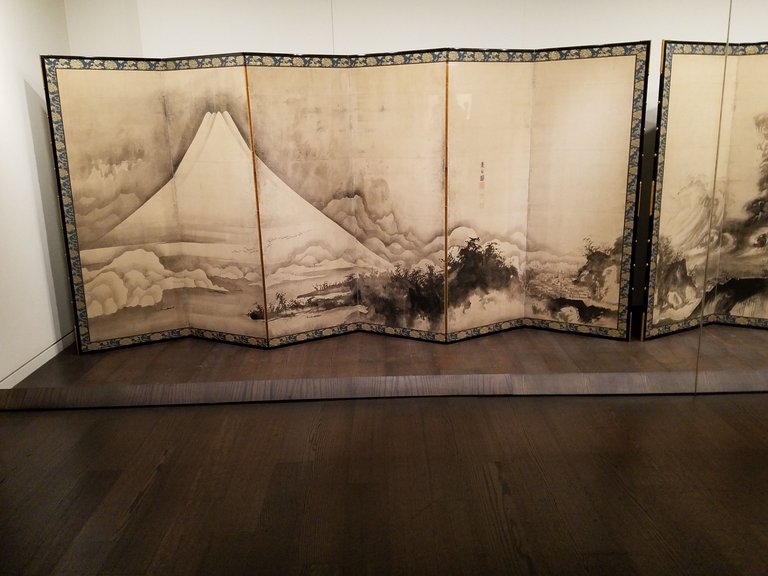

Chimera / Winged Beast (Tomb Figure)
Gray earthenware, slip-coated with polychrome pigments
Western Han dynasty (206 B.C. – 9 A.D.)
China
Like winged chimeras of the ancient Near East, this alert tomb guardian is a mythical hybrid of real and imaginary creatures. Its wolfish head, tautly arched body, long, flat wings, and short, powerfully modeled legs are abstracted to rounded masses and curving forms that swell with pent-up energy. Known by several names in ancient Chinese texts - including "bixie" (averter of evil) - fantastic, protective beasts like this example in clay are derived from earlier forms in bronze. A square notch cut behind its neck suggests that this dynamic figure, like some earlier bronzes, originally served as the base for a vertical pole. Together with a second figure, it may have supported the frame for a set of bells of chimes.
Gift of Stanley Herzman in memory of Gladys Wolfson Herzman; Avery Brundage, Louise Lutz and Russell Tyson Endowments
1997.337
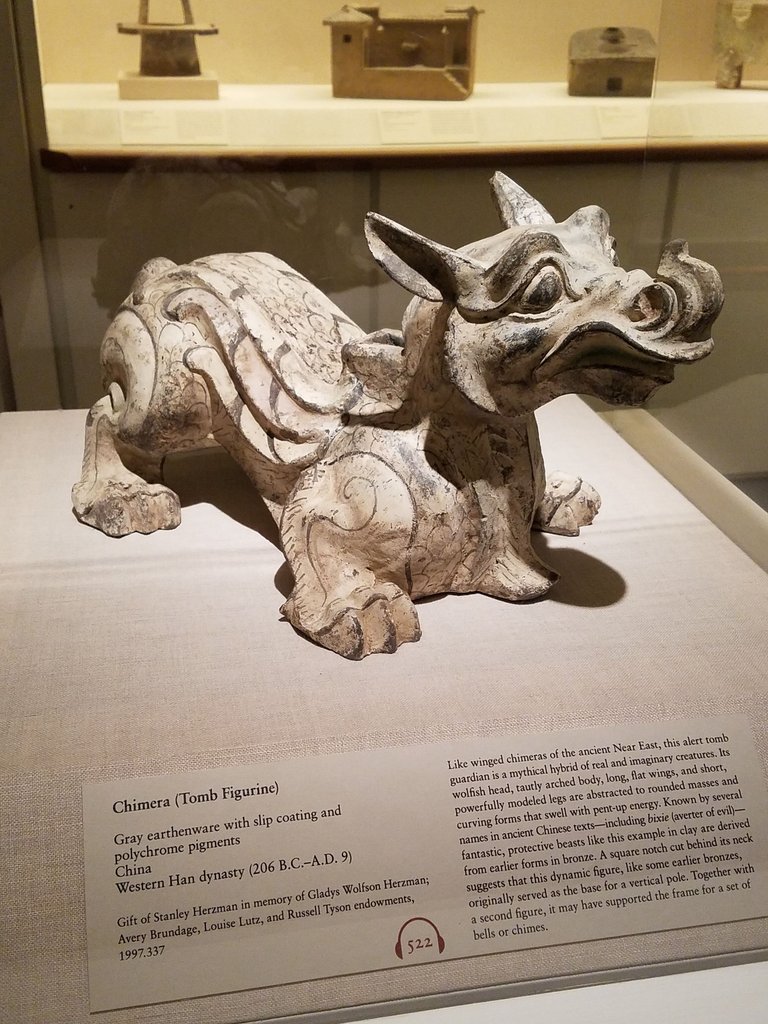
Mastiff (Tomb Figurine)
Brick-red earthenware with green lead glaze
Eastern Han dynasty (A.D. 25 – 220), 2nd century
China
Tomb models such as this alert watchdog reflect an increasingly humanistic and mundane view of the afterlife. Its compact, hollow earthenware body has been molded in two halves, joined lengthwise along the head, chest, back, and rump. The lead glaze, colored green by the addition of copper oxide, has decomposed into thin layers that reflect light with silvery iridescence.
Gift of Russell Tyson
1950.1630
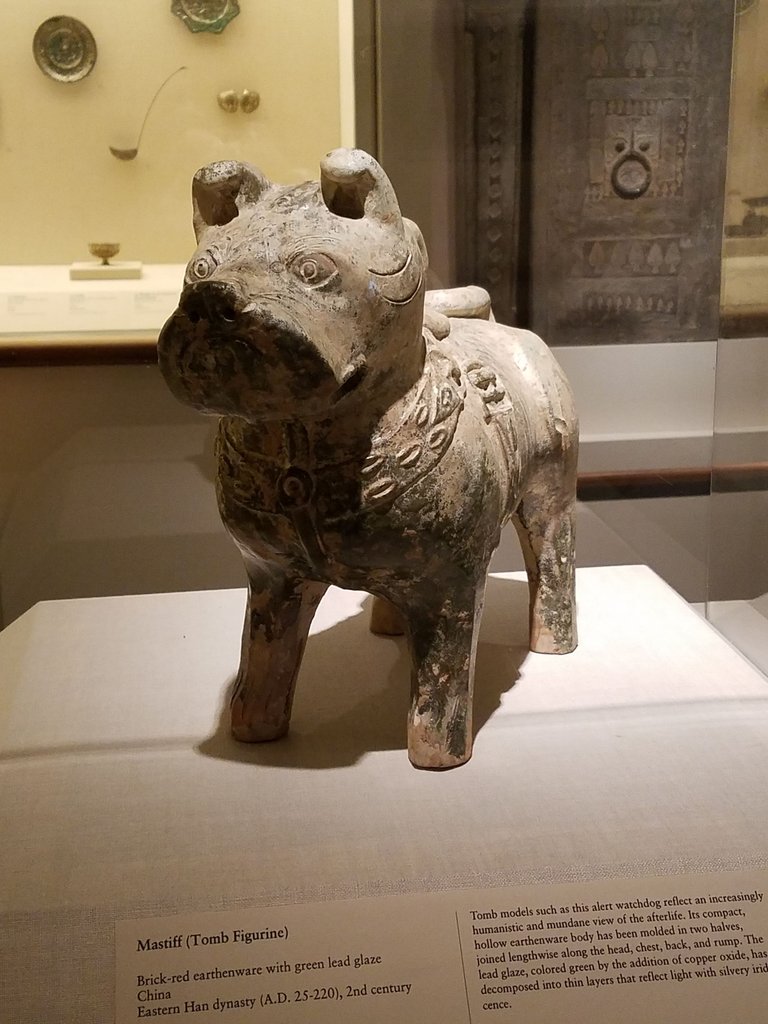
Tapir-Shaped Container (Xi Zun)
Bronze inlaid with gold, silver, and turquoise
Song dynasty (960 - 1279) or Ming dynasty (1368 - 1644)
China
Private loan
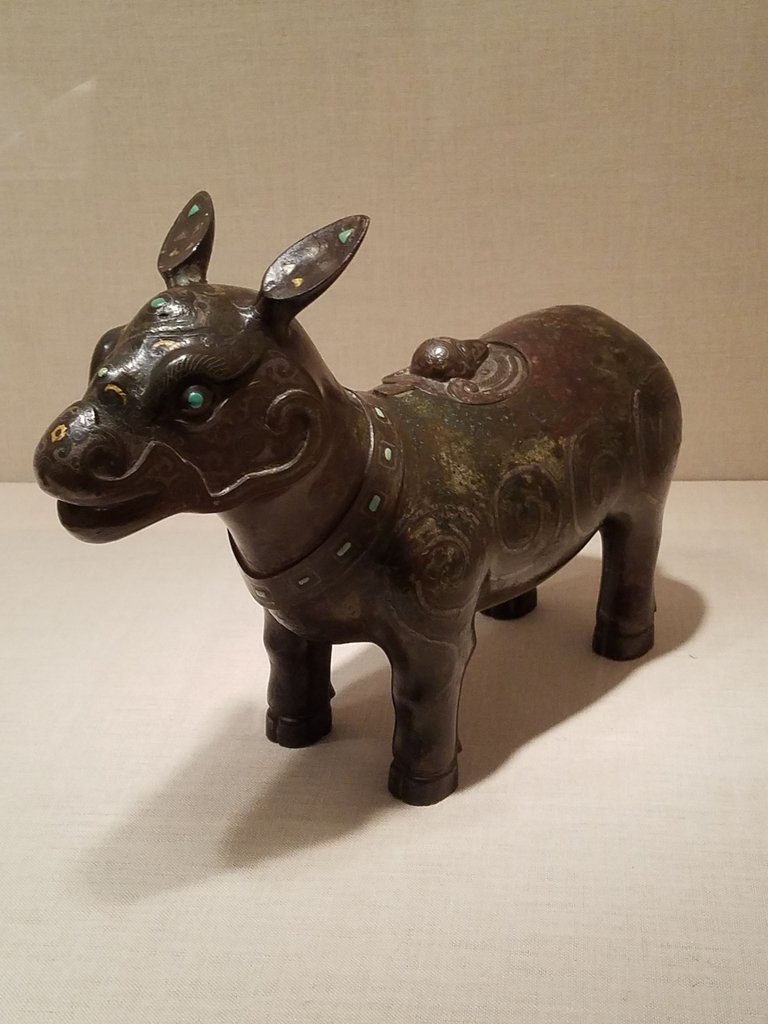
Vessel in Form of a Bird, first half of 8th century
Earthenware with three-color (sancai) lead glazes
Tang dynasty (618 – 907)
China
This bird-shaped clay vessel features naturalistic wing and tail feathers but decorative scrollwork along the neck and body. It is painted with lead-based three-color (sancai) glazes that were commonly used during the Tang dynasty. The bird may be either a mandarin duck or a wild goose; both traditionally symbolized peace, prosperity, and marital love.
Bequest of Janis H. Palmer
1986.945
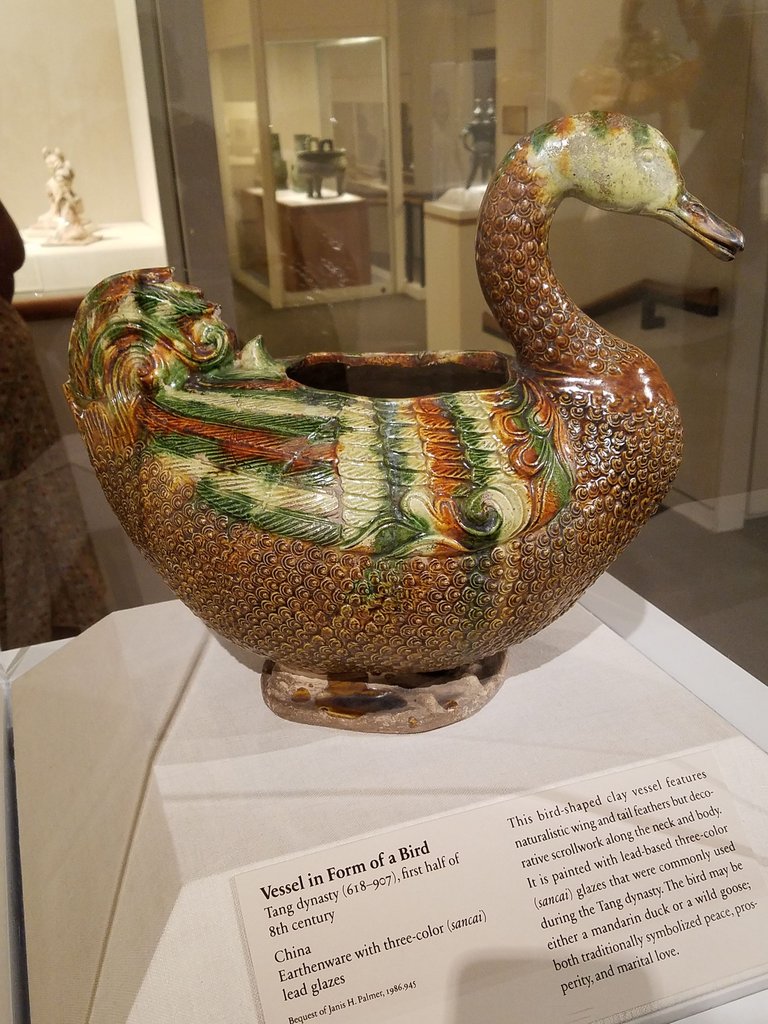
Votive Plaque with God Vishnu, 19th century
Gilt bronze with ivory, semiprecious stones, crystal, and glass
Nepal
Kathmandu Valley
James W. and Marilynn Alsdorf Collection
1982.1674
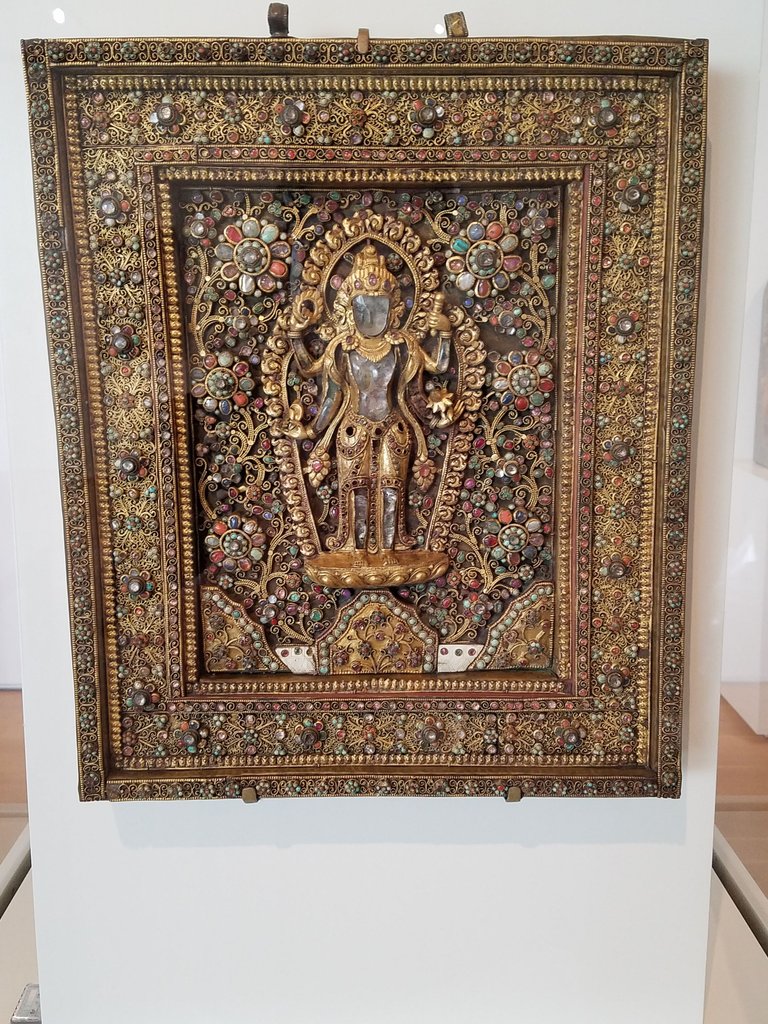
Guardian Lion
Sandstone
Angkor period, 12th century
Cambodia
Gift of Marilynn B. Alsdorf
1997.713
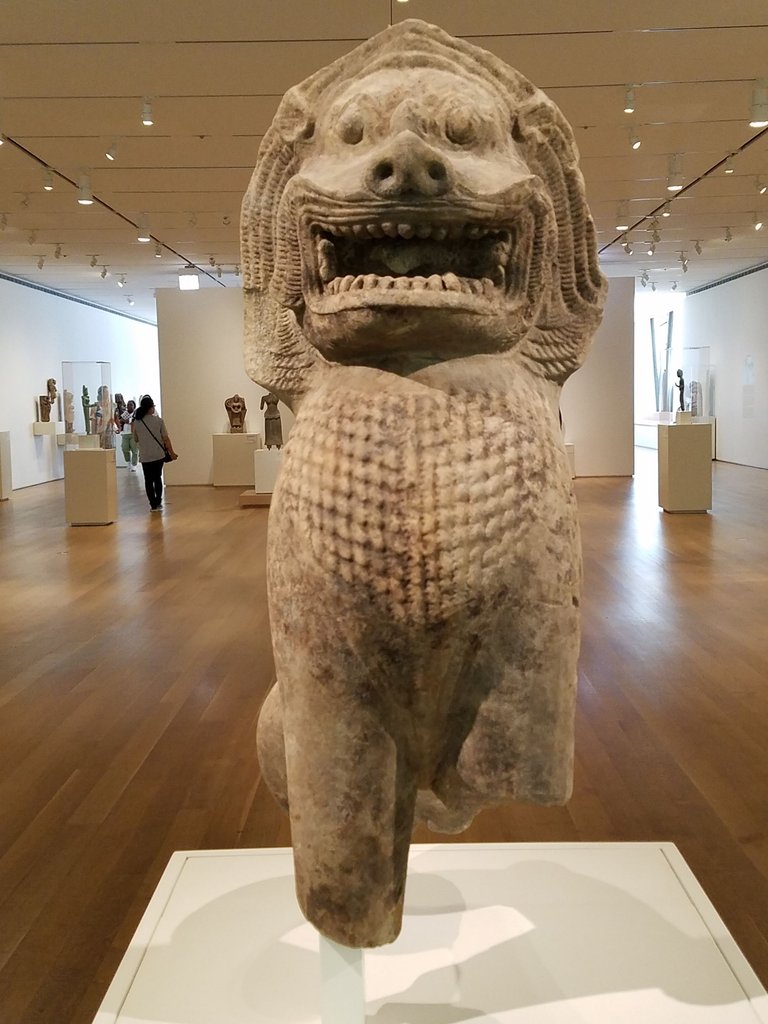
ARTS OF THE AMERICAS
Figure of a Dog, 1 – 200 CE
Ceramic and pigment
Colima
Colima, Mexico
Ruth Falkenau Fund
1995.20
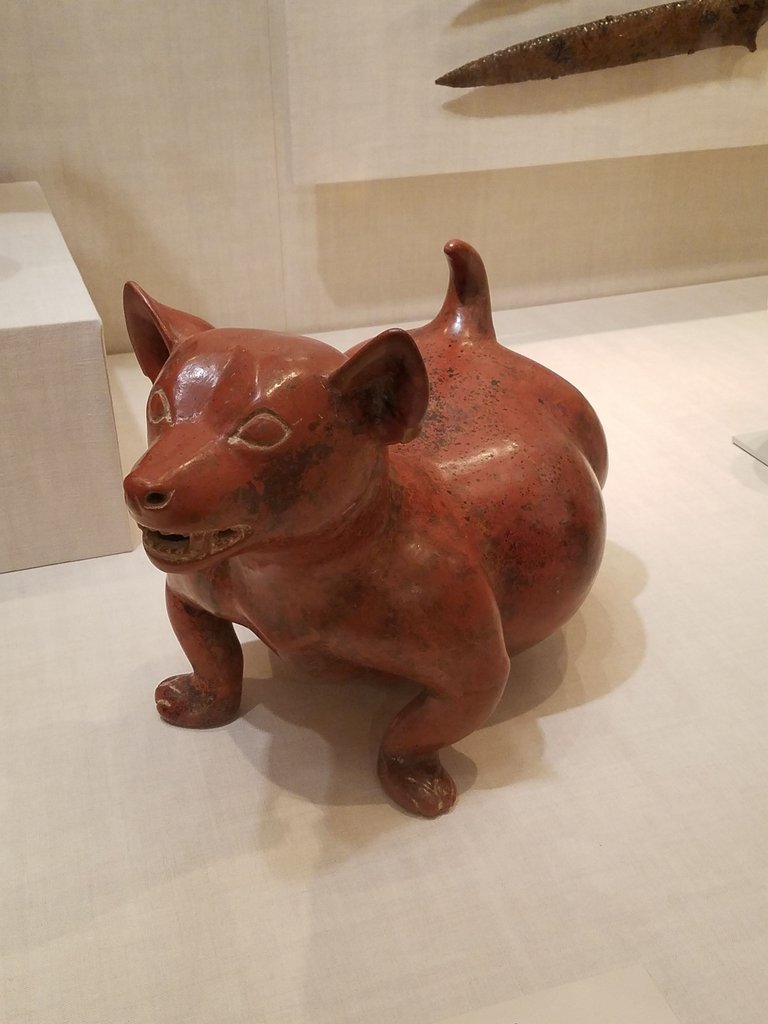
Vessel in the Form of a Pampas Cat, 180 B.C. / A.D. 500
Ceramic and pigment
Nazca
South coast, Peru
Kate S. Bucskingham Endowment
1955.1848
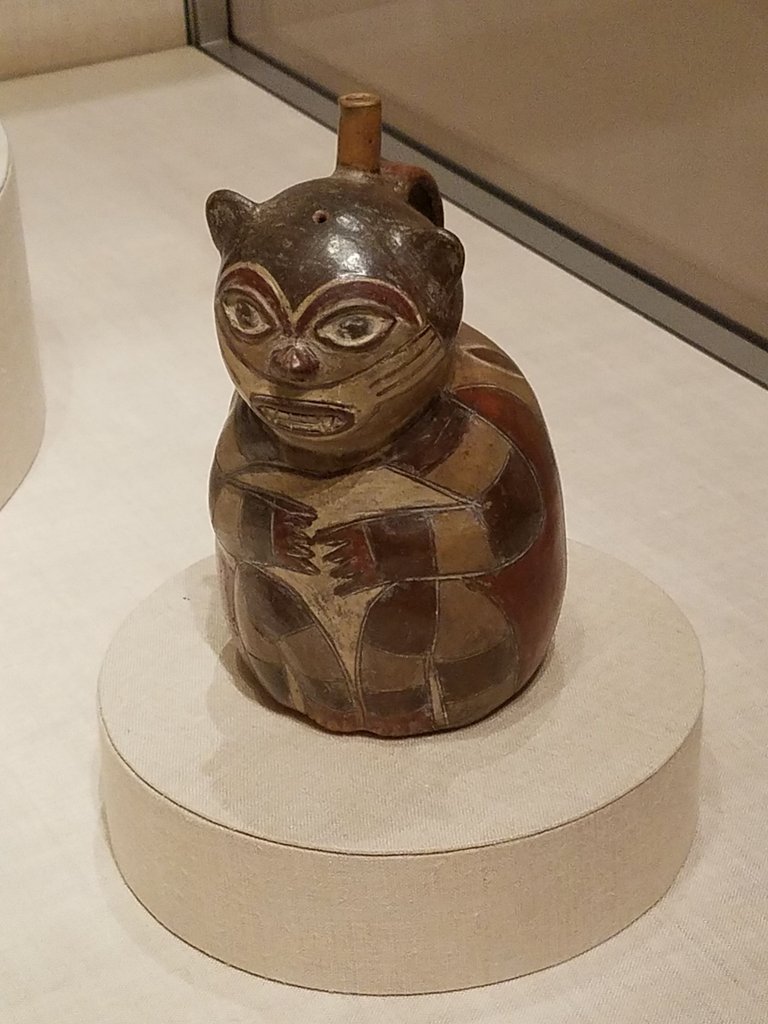
Otorongo, 2020
Coil-built clay with pre-fire slip-paint and vegetal resins
Celia Vasquez Yui
Shipibo, born 1960
This jaguar, or "otorongo" in Quechua, was created as part of Vasquez Yui’s series "The Council of the Mother Spirits of the Animals," which advanced a spiritual understanding of ecology. The feline confronts our human gaze, as if acknowledging the devastating losses of habitat in the Amazon Jungle. The cat’s spotted fur is elaborately rendered in finely incised and painted patterns called "kené." These designs represent worldviews and energy pathways and can be evoked in song to promote healing.
Arts of the Americas Discretionary Fund
2022.161
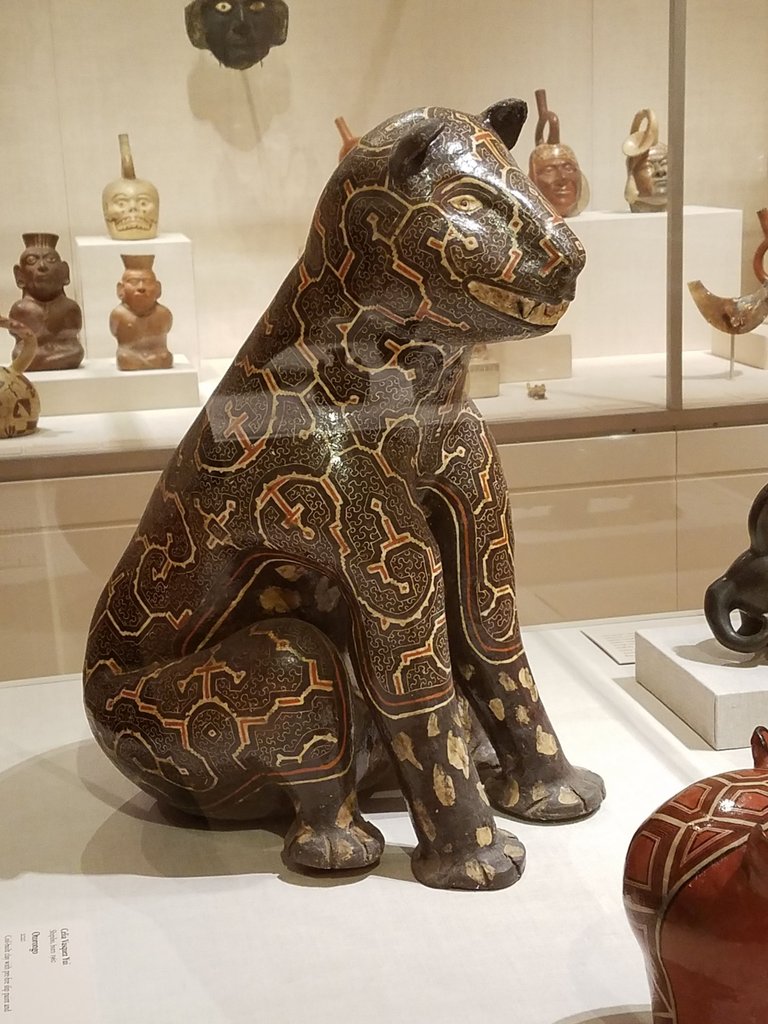
Feline Vessel with Stirrup Spout, 1100 – 1470
Ceramic
Chimú
Peru, likely north coast
Felines have been a prominent and recurring feature of ancient Andean art for millennia. Examples like this blackware vessel have been identified as representing pumas—the largest predator in this mountainous habitat. These fierce hunters became symbols of power within many societies. As numerous works in this gallery show, makers often portrayed authoritative human figures and divine beings with feline attributes like fangs, claws, and whiskers.
Kate S. Buckingham Endowment
1955.2383
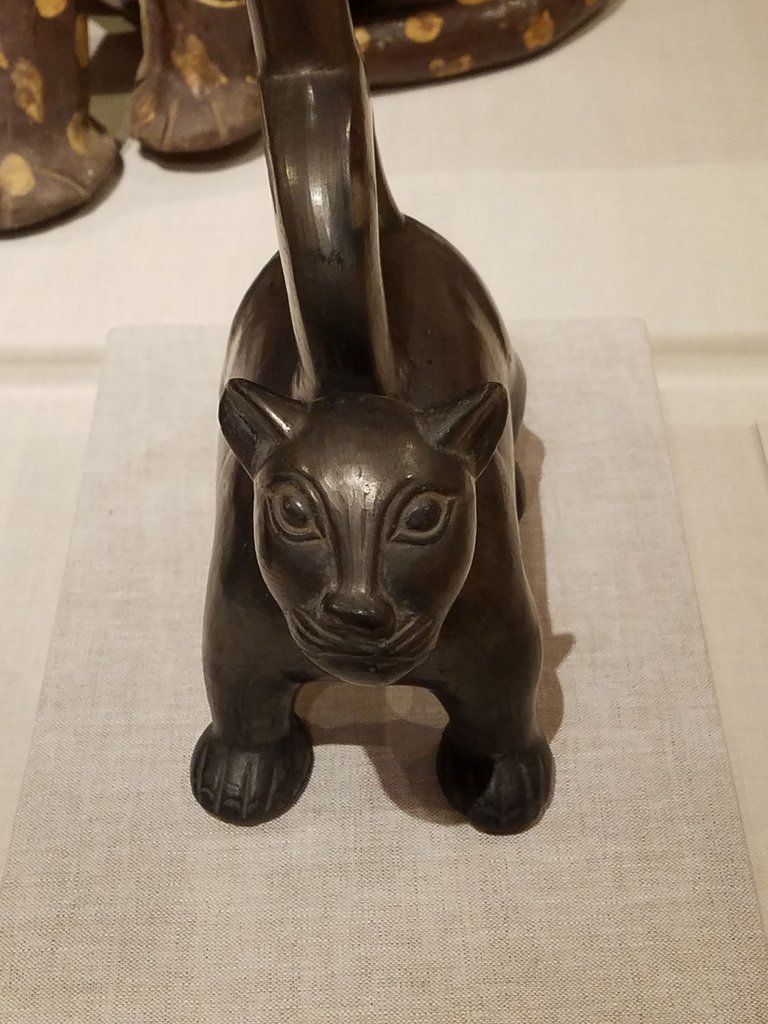
Vessel in the Form of a Deer Impersonator
Vessel in the Form of a Deer Impersonator
Vessel in the Form of a Masked Drummer
Vessel in the Form of the Head of a Llama
100 BCE – 500 CE
Ceramic and pigment
Moche
Chimbote, Santa Valley, north coast, Peru
Gift of Nathan Cummings
1956.346
1958.708
1957.424
1957.398
Fragment of a Vessel in the Form of a Puma, 100 BCE – 500 CE
Ceramic and pigment
Moche
North coast, Peru
Kate S. Buckingham Endowment
1955.2298
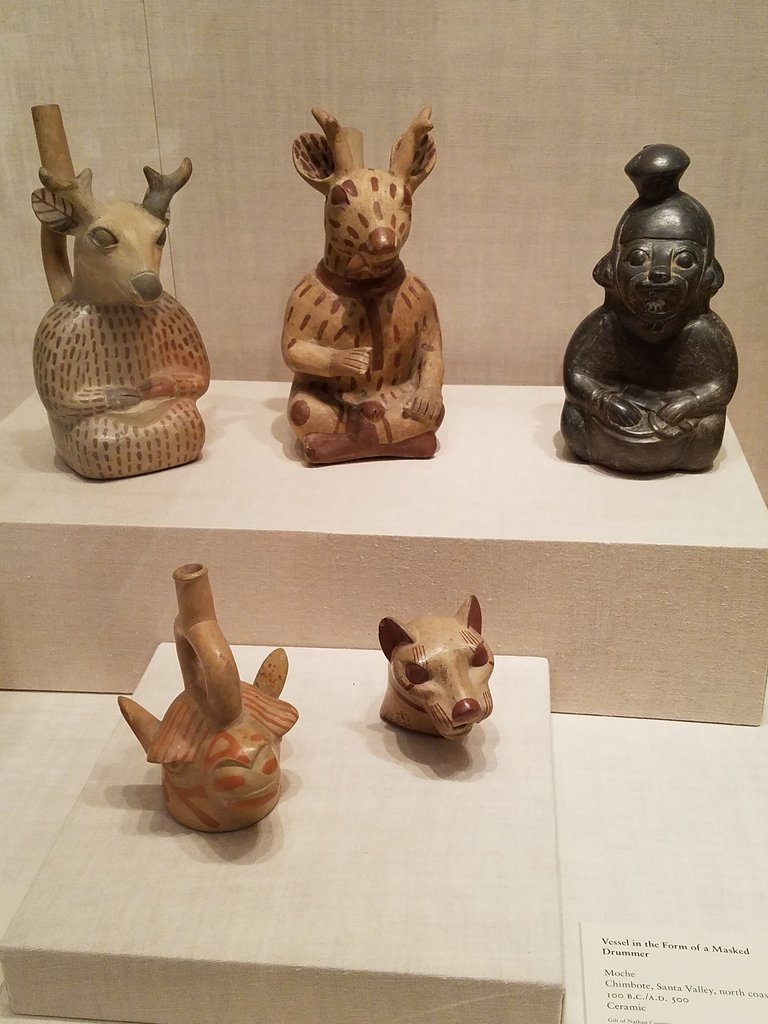
PHOTOGRAPHY
Negative Cat, c. 1926
Gelatin silver print
László Moholy-Nagy
American, born Hungary, 1895 – 1946
Julien Levy Collection, Special Photography Acquisition Fund
1979.82
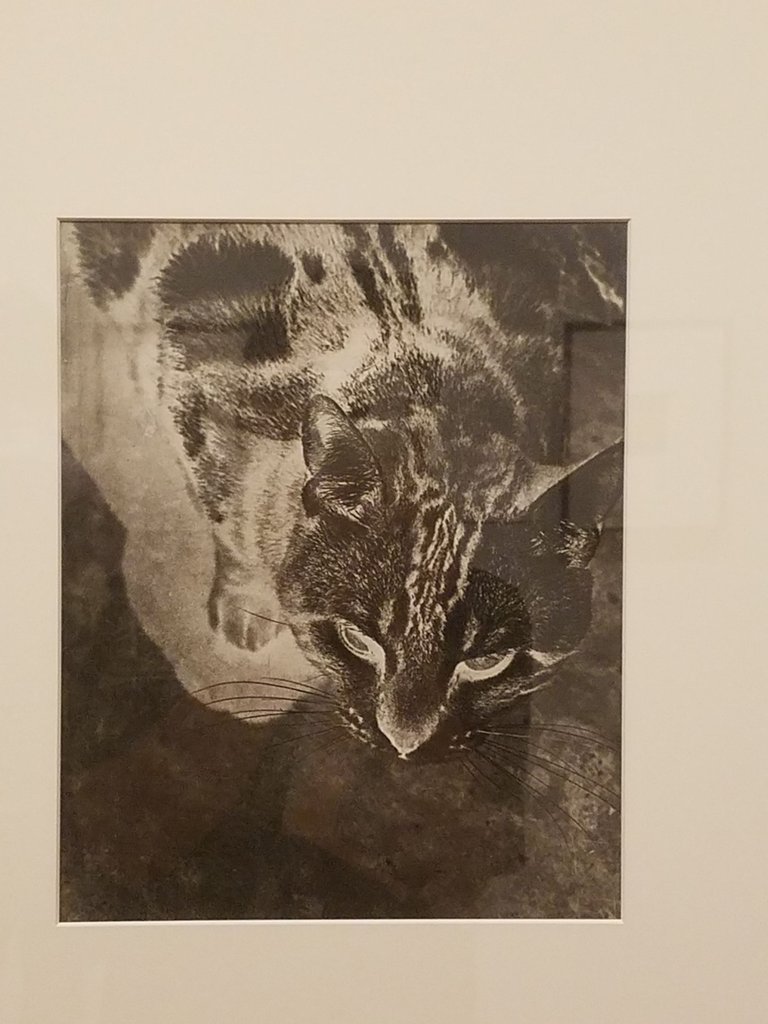
GIFT SHOP
The gift shop in the modern wing offers several limited edition sculptures by Jeff Koons:
Jeff Koons
Balloon Dog (Yellow)
Porcelain
$11,000 Retail
$9,000 on eBay
$10,000 at https://www.jomashop.com/jeff-koons-jkoonsbdy15.html
10 1/2 x 10 1/2 x 5 inches
26.7 x 26.7 x 12.7 cm
Edition of 2300 plus 50 APs
2015
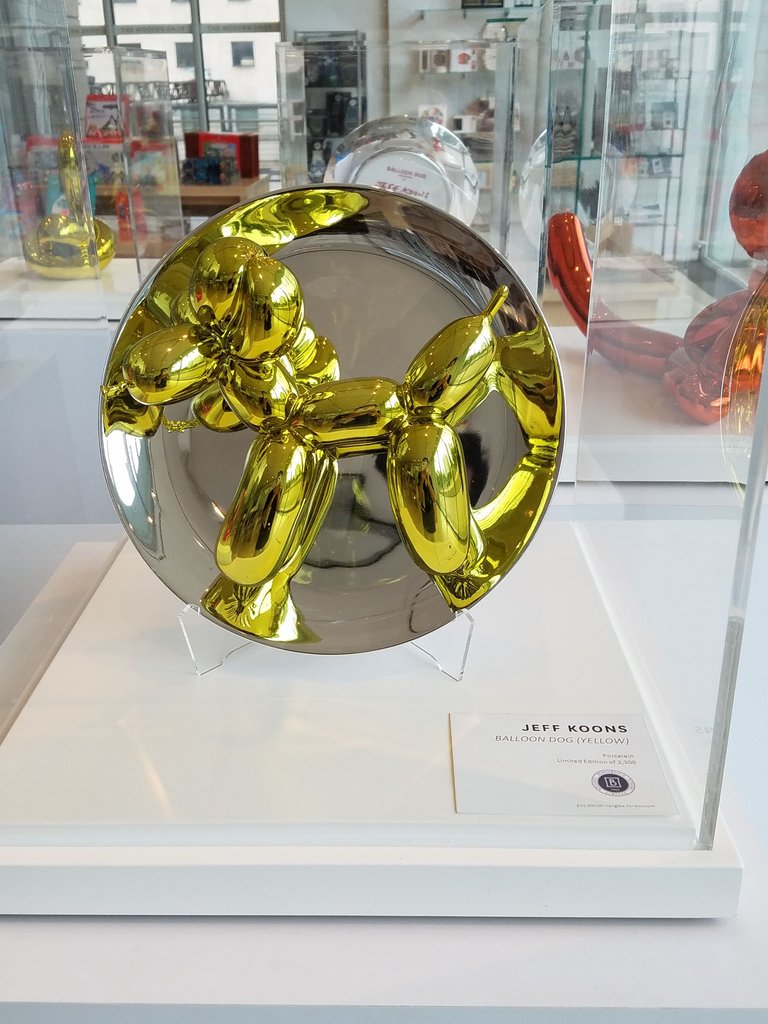
Jeff Koons
Balloon Monkey (Orange)
Porcelain
$14,500 Retail
$13,000 at https://www.jomashop.com/jeff-koons-jkoonsbmo19.html
9 13/16 x 15 7/16 x 8 1/4 inches
24.9 x 39.2 x 21 cm
Edition of 999 plus 50 APs
2017
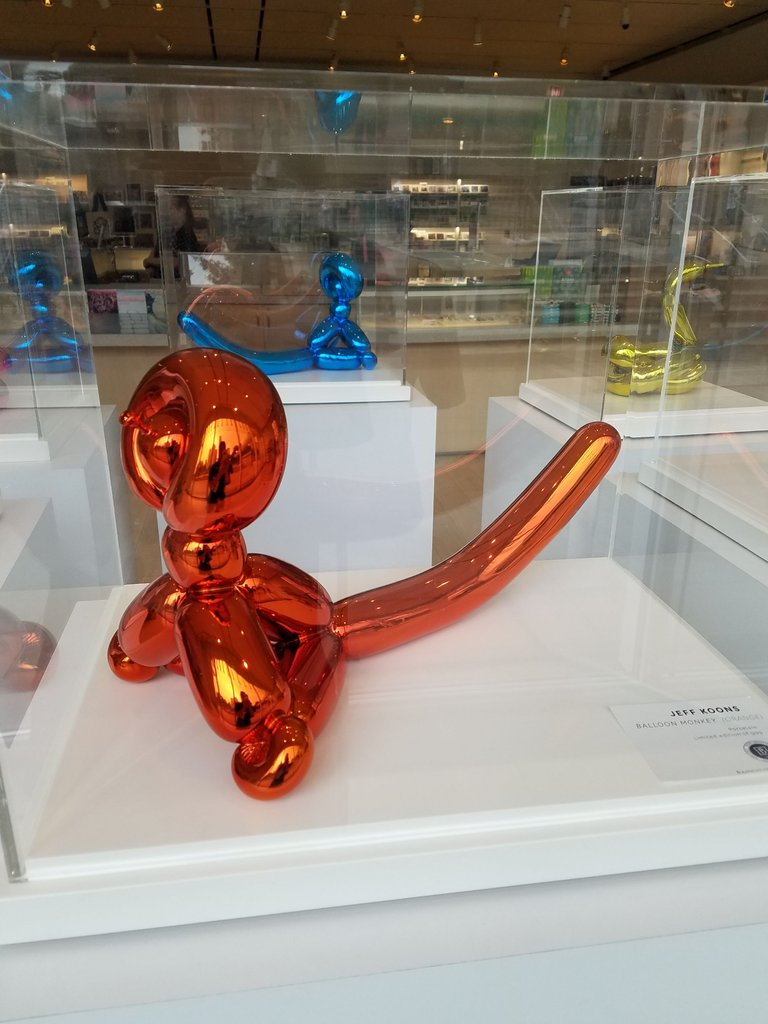
Jeff Koons
Balloon Swan (Magenta)
Porcelain
$14,500 Retail
$13,000 at https://www.jomashop.com/jeff-koons-jkoonsbsm19.html
9 1/2 x 8 1/4 x 6 7/16 inches
24.1 x 21 x 16.4 cm
Edition of 999 plus 50 APs
2017
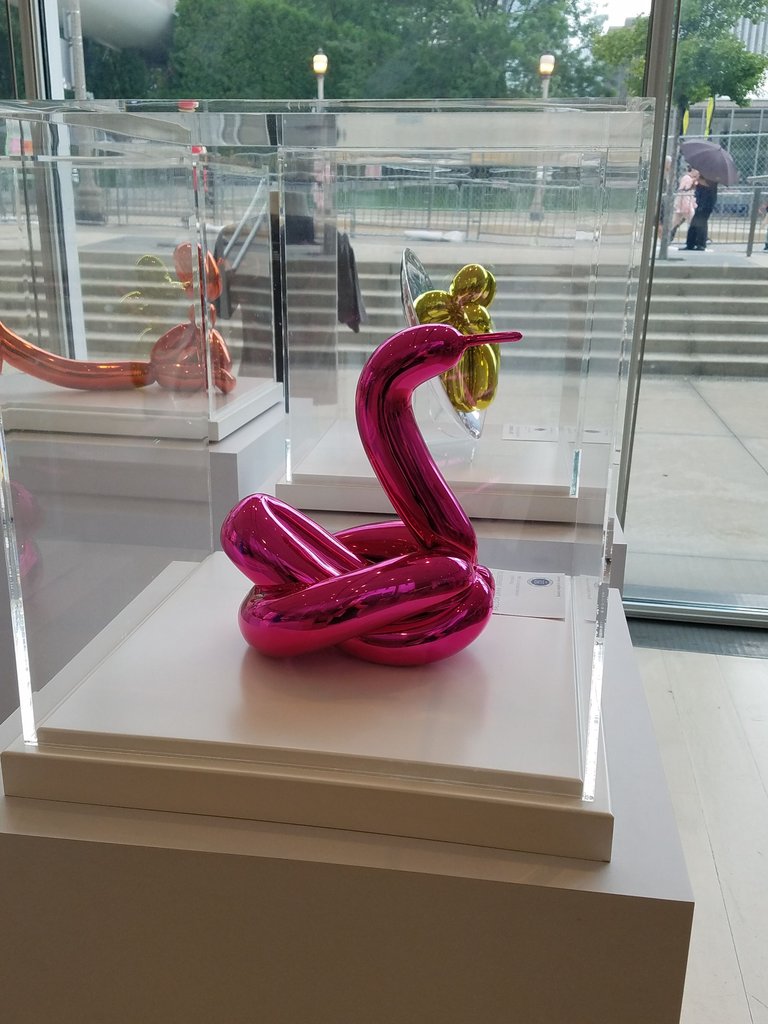
Balloon Dog (Magenta)
$11,000 Retail
$10,000 at https://www.jomashop.com/jeff-koons-jkoonsbdm15.html
Balloon Swan (Yellow)
$15,000 Retail
$13,5000 at https://www.jomashop.com/jeff-koons-jkoonssy17.html
Balloon Monkey (Blue)
$15,000 Retail
$13,5000 at https://www.jomashop.com/jeff-koons-jkoonsmb17.html
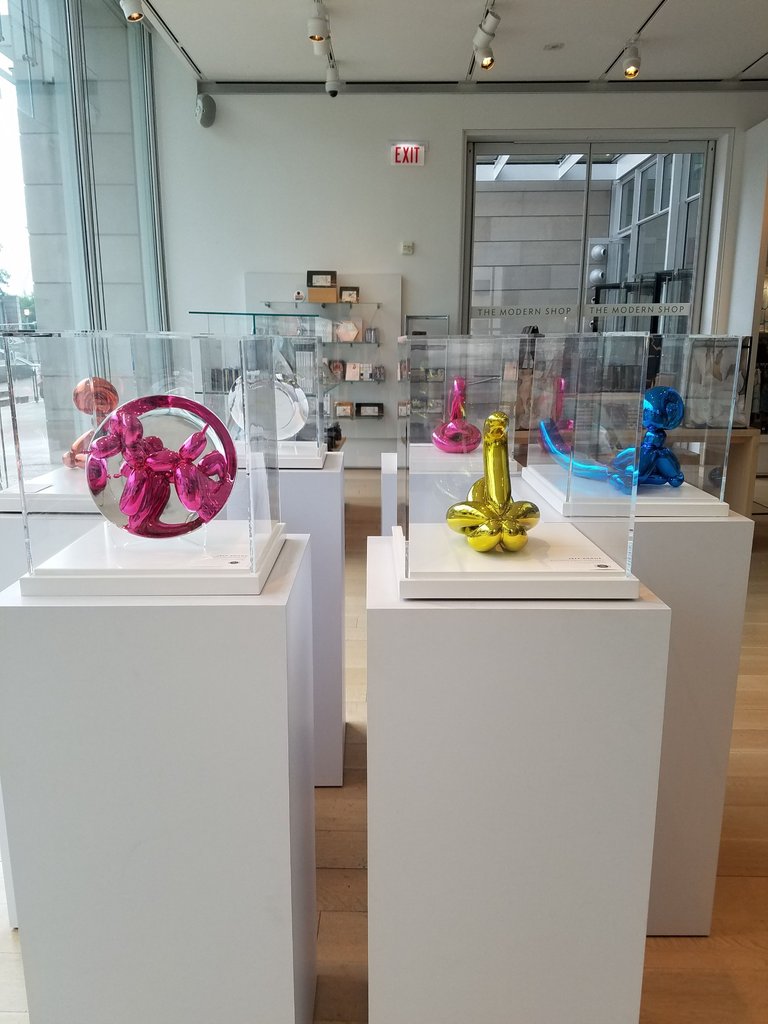
The Art Institute also has a lot of paraphernalia based on its iconic bronze Lion statues (ROAR!), which have become the symbolic mascot of the museum:
The Art Institute of Chicago Lion Plush
$25
https://shop.artic.edu/products/288330
The Art Institute of Chicago Plush Wreath
$10
https://shop.artic.edu/products/288873
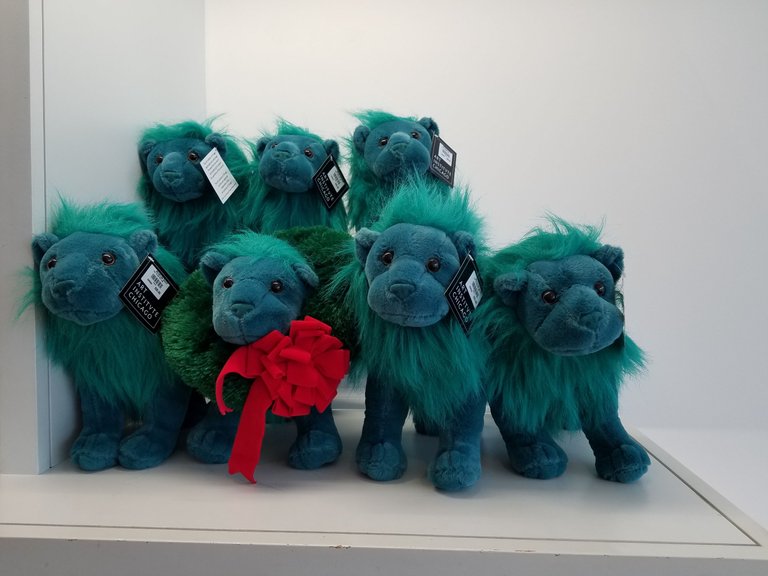
Lion Extra Large Mug
$19.95
https://shop.artic.edu/products/285680
Lion Cap
$24
https://shop.artic.edu/products/283053
Lion Socks
$14
https://shop.artic.edu/products/283076
Lion Enamel Key Chain
$11.95
https://shop.artic.edu/products/283070
Lion Journals—Pair
$14.95
https://shop.artic.edu/products/283073
Lion Water Bottle
$35
https://shop.artic.edu/products/286231
Lion Youth Socks
$12
https://shop.artic.edu/products/283074
Lion Umbrella
$38
https://shop.artic.edu/products/283066
Lion Black Youth T-Shirt
$25
https://shop.artic.edu/products/283884
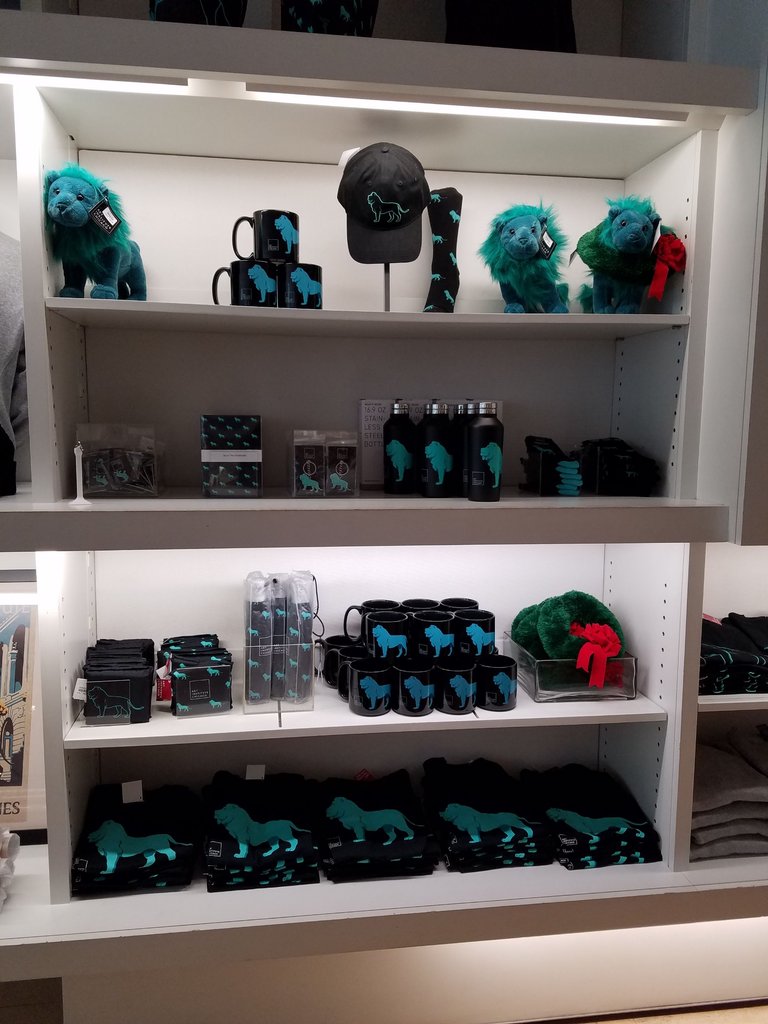
Lion Outline Foldable Tote
$20
https://shop.artic.edu/products/283069
Lion Foldable Tote
$20
https://shop.artic.edu/products/283067
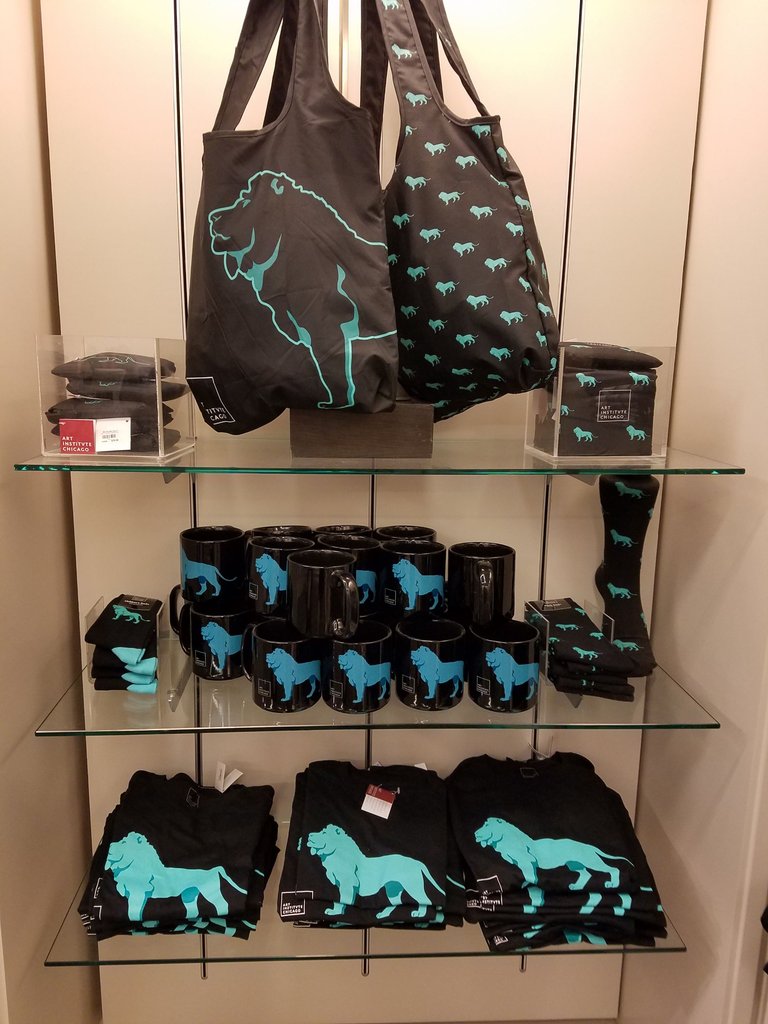
Lion Beanie Hat
$25
https://shop.artic.edu/products/284914
Lion Black T-Shirt
$25
https://shop.artic.edu/products/283065
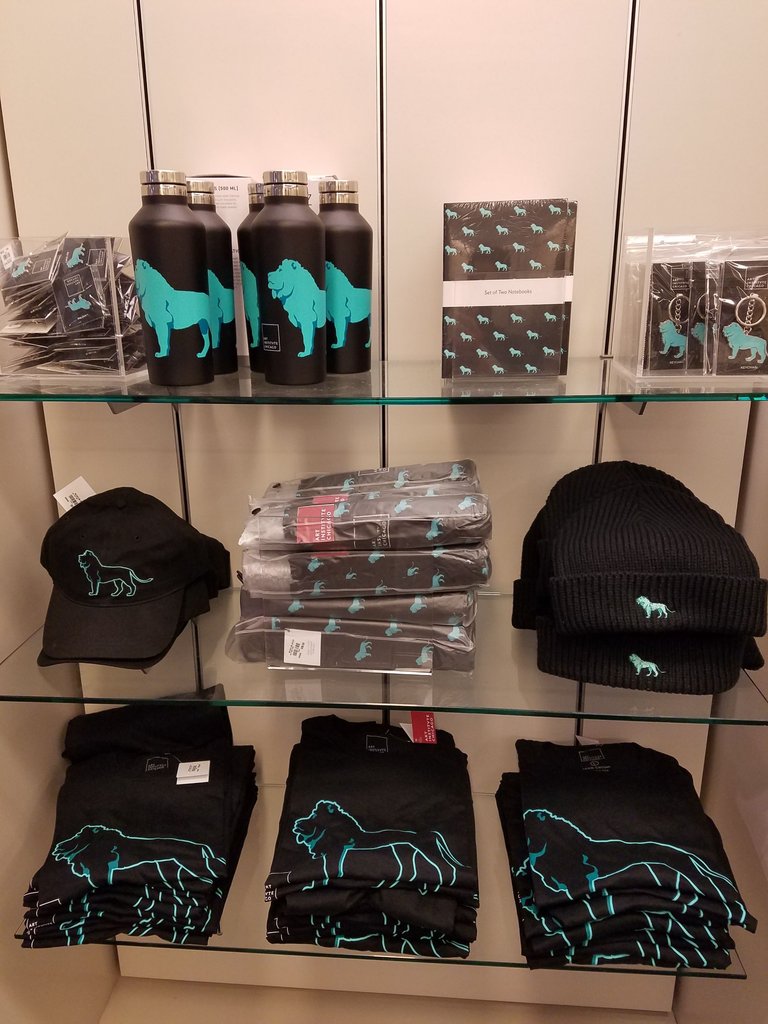
Lion Bookends—Pair
$250 (Currently sold out)
https://shop.artic.edu/products/39728
Lion Bookend—Tail Pointing Down
$150
https://shop.artic.edu/products/41520
Lion Wreath Ornament
$12
https://shop.artic.edu/products/9399
Painted Lion Facade Magnet
$6
https://shop.artic.edu/products/63414
Painted Lion Holiday Magnet
$6
https://shop.artic.edu/products/82997
Lion Paperweight
$75
https://shop.artic.edu/products/46210
Painted Lion Façade Coaster
$9.95
https://shop.artic.edu/products/79494
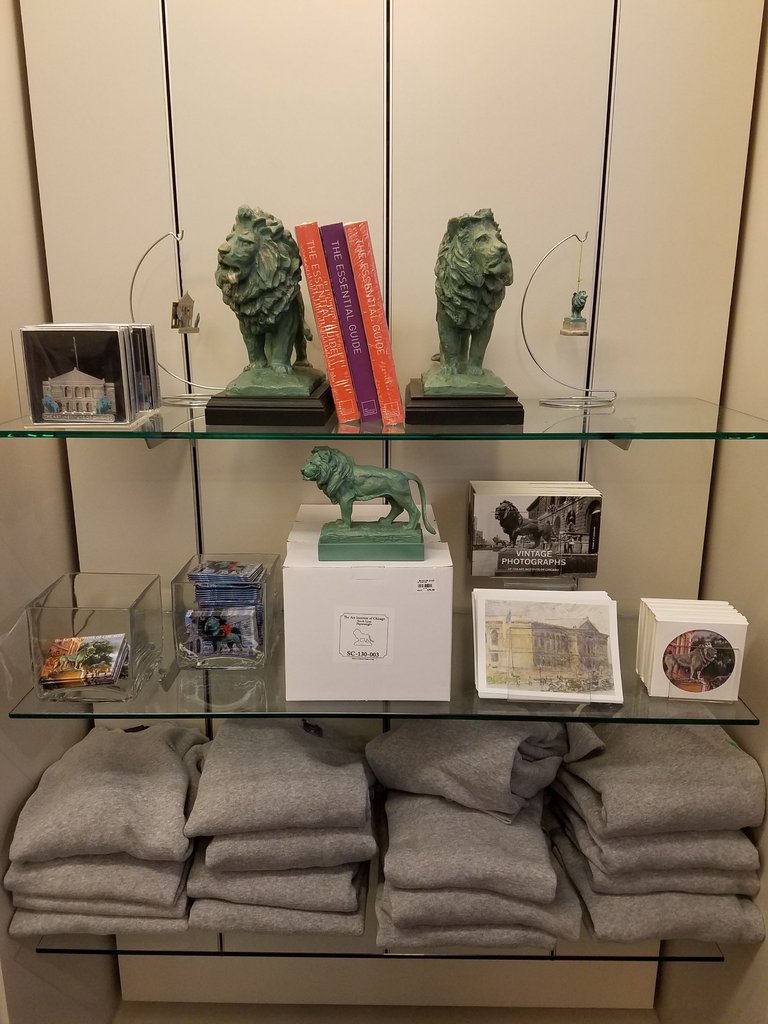
Horse-drawn wagon in front of the Art Institute of Chicago Holiday Cards
$19.95
https://shop.artic.edu/products/286567
Lion Snow Globe
$35
https://shop.artic.edu/products/285849
Holidays At The Museum Cards
$19.95
https://shop.artic.edu/products/288091
Holidays at the Museum Mug
$30
https://shop.artic.edu/products/288299

These were some interesting masks that stood out:
Omy 3D Mask - Rex
$29.99
https://us.omy-maison.com/products/3d-cardboard-mask-rex
Omy 3D Mask - Sharky
$31
https://us.omy-maison.com/products/shark-3d-mask
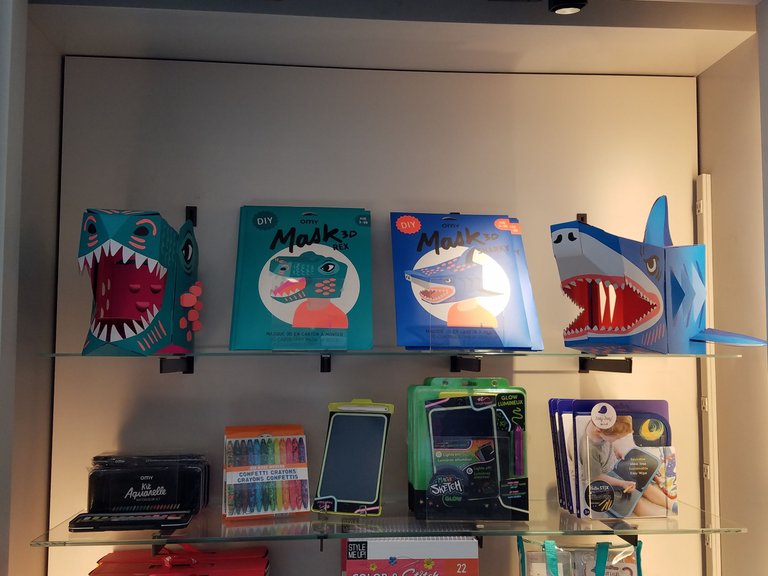
The Art Institute also offers a variety of prints, magnets, and shirts centered around famous paintings.
Steinlen Cats Magnet Set
$8.95
https://shop.artic.edu/collections/magnets/products/120836

George Baxter Puss Napping Magnet
$6
https://shop.artic.edu/collections/magnets/products/123011
Georges Seurat A Sunday Afternoon on La Grande Jatte —1884 Magnet
$6
https://shop.artic.edu/collections/magnets/products/4883
I actually bought the Puss Napping magnet! After my visit, when I was perusing the gift shop, this cat magnet really caught my attention, especially because I did not recall seeing the artwork. After asking the Art Institute staff, they confirmed that the Art Institute did not own the painting nor was it on display. I surmise it must have been featured in some past special exhibit. I did not buy the magnet immediately but a few days later, when I was in downtown Chicago again, I went out of the way just to buy this magnet because the art just appealed to my inner kitty.
Also, many years ago, I bought a magnet of Renoir's Two Sisters as a gift.

Congratulations @byzantinecat! You have completed the following achievement on the Hive blockchain And have been rewarded with New badge(s)
Your next target is to reach 20 posts.
You can view your badges on your board and compare yourself to others in the Ranking
If you no longer want to receive notifications, reply to this comment with the word
STOPCheck out our last posts: